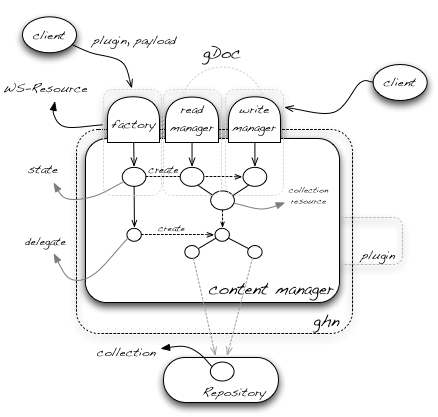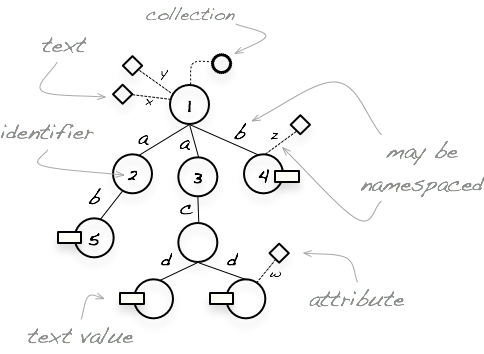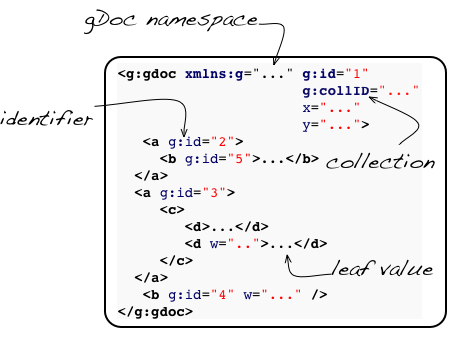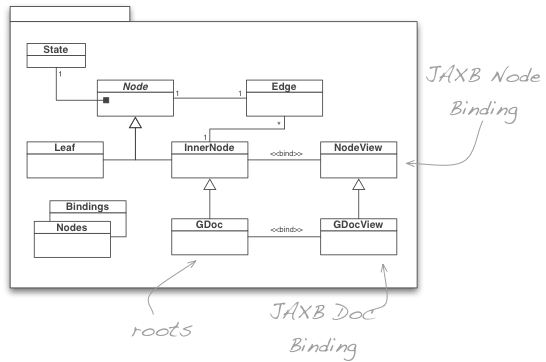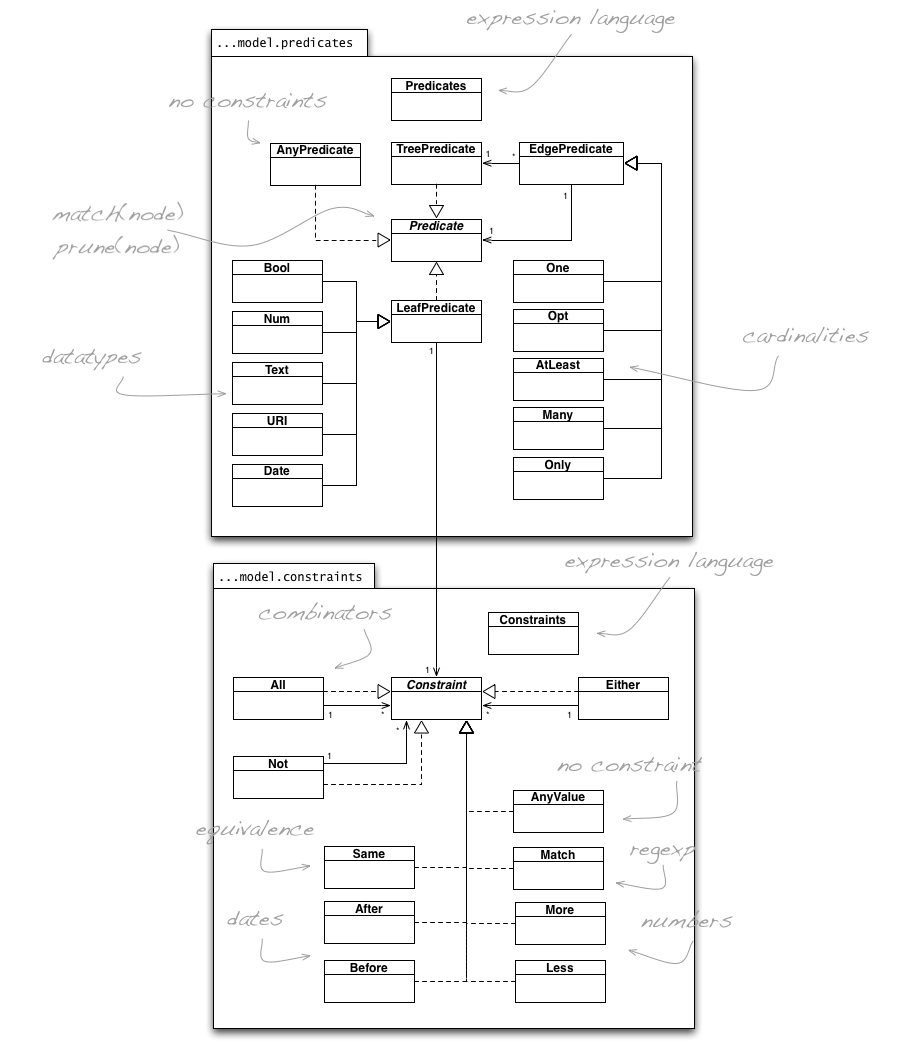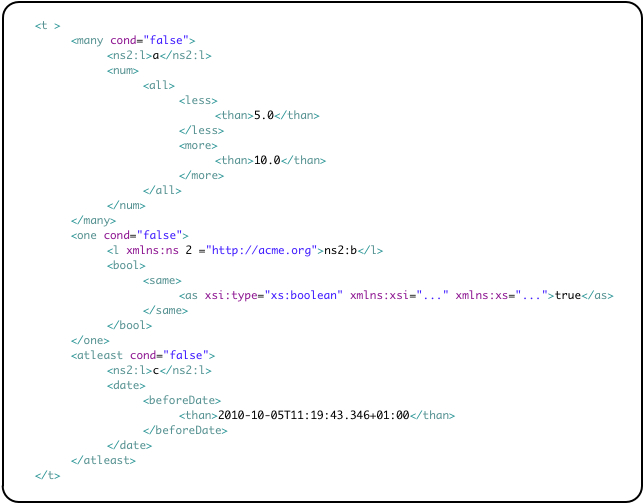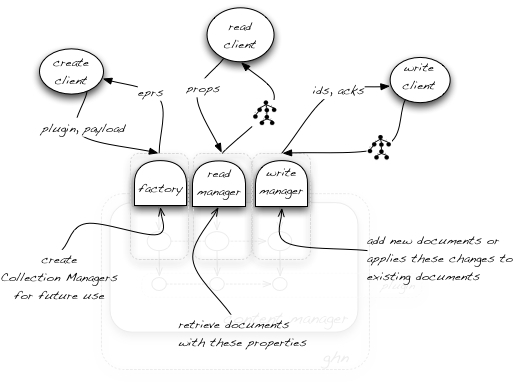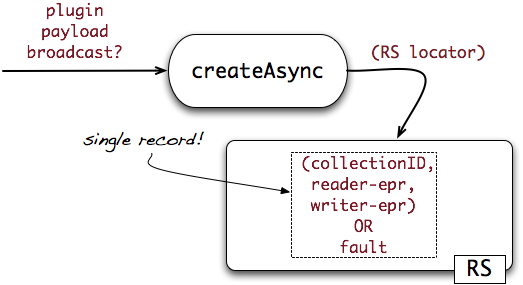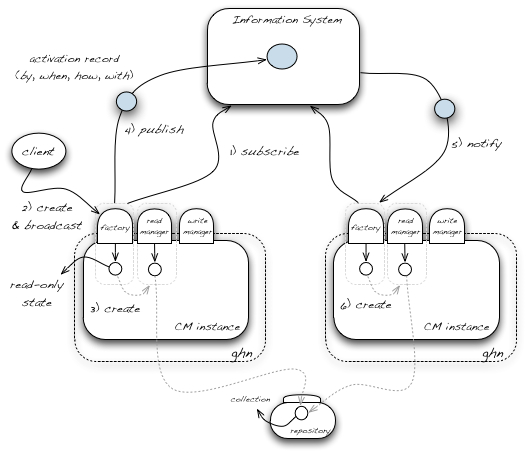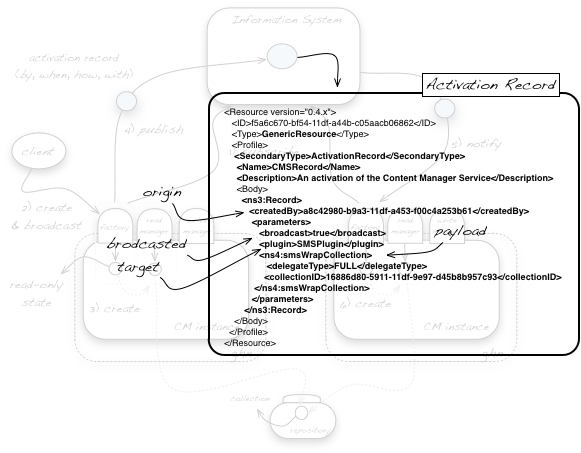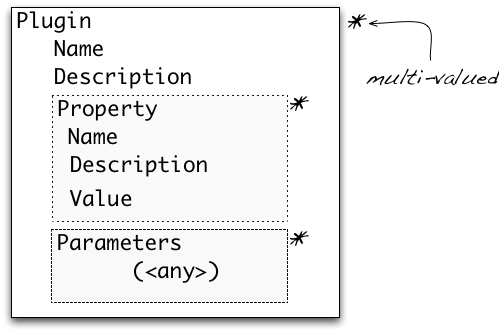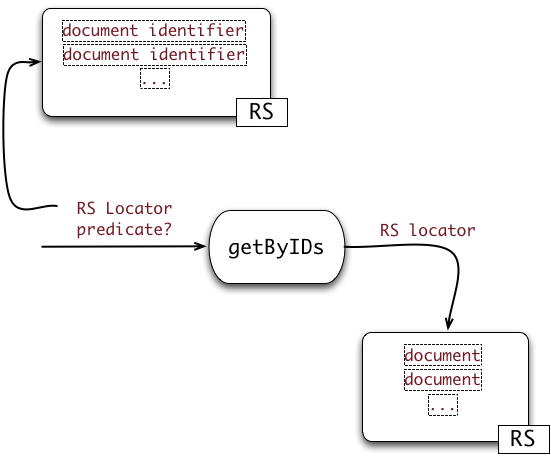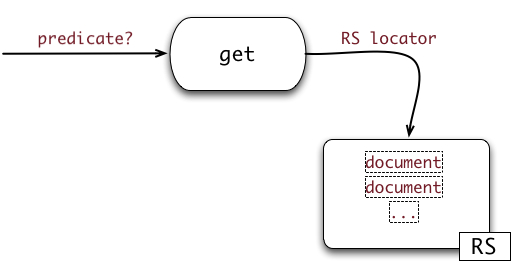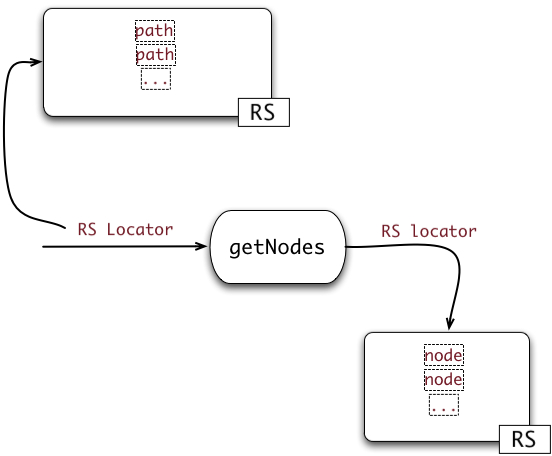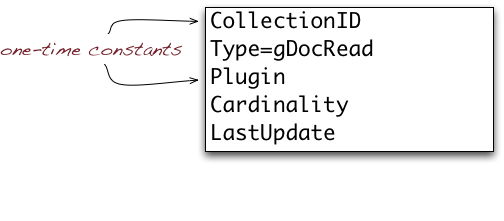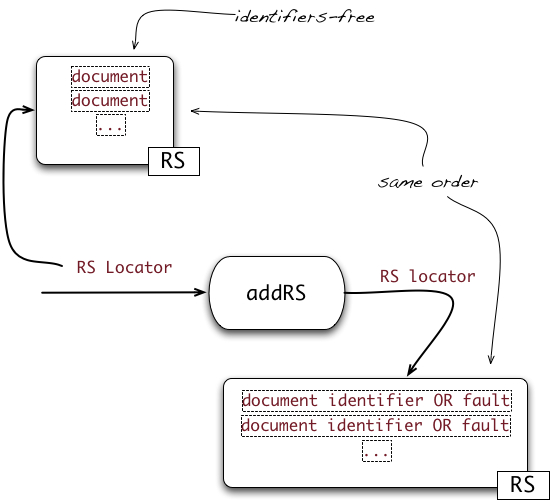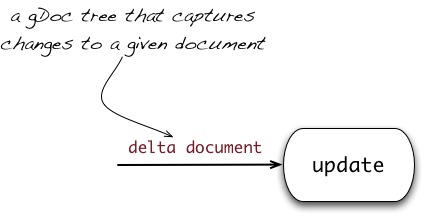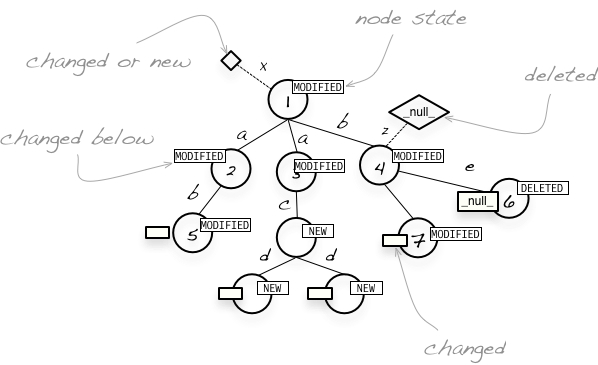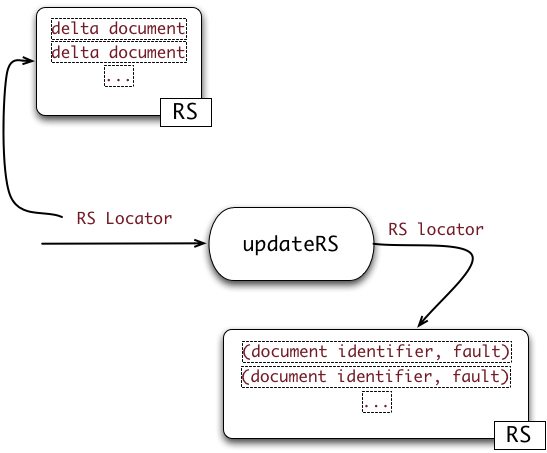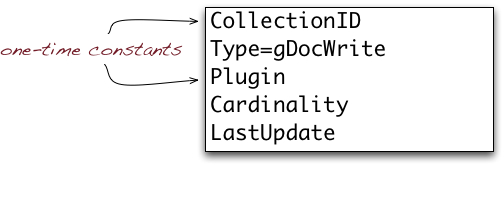Difference between revisions of "Content Manager"
(→Factory) |
(→Plugins) |
||
| (42 intermediate revisions by 2 users not shown) | |||
| Line 1: | Line 1: | ||
| − | The Content Manager service | + | The Content Manager service gives uniform access to content served by a variety of back-ends, both inside and outside the system. It is the central component of the gCube [[GCube_Information_Organisation_Services_(NEW)|subsystem]] which deals with the organisation of content and related data. |
| + | We overview here the architecture, content model, and interfaces of the service . | ||
| + | Related libraries, such as the [[Content_Manager_Library|Content Manager Library]] (CML) and the [[gCube_Document_Library|gCube Document Library]] (gDL), are discussed separately. | ||
| − | = | + | |
| + | = Architecture = | ||
The Content Manager is designed as an [[OCMA:_The_Open_Content_Management_Architecture|OCMA]] service. In OCMA terms, it classifies as a [[OCMA:_The_Open_Content_Management_Architecture#Service_Classes|''multi-type'', ''1-N adapter'']] service: | The Content Manager is designed as an [[OCMA:_The_Open_Content_Management_Architecture|OCMA]] service. In OCMA terms, it classifies as a [[OCMA:_The_Open_Content_Management_Architecture#Service_Classes|''multi-type'', ''1-N adapter'']] service: | ||
| − | * it is a multi-type service because it supports two front types for, respectively, reading and writing content modelled as labelled trees. | + | * it is a ''multi-type service'' because it supports two front types for, respectively, reading and writing content modelled as labelled trees. |
:Collectively, the front types and the tree content model form the ''<code>gDoc</code>'' access type of the service. | :Collectively, the front types and the tree content model form the ''<code>gDoc</code>'' access type of the service. | ||
| − | * it is an adapter service because it adapts the <code>gDoc</code> access type to multiple back types, where each back type corresponds to the | + | * it is an ''adapter service'' because it adapts the <code>gDoc</code> access type to multiple back types, where each back type corresponds to the interface and content model of a class of remote repositories. |
:For this, the service employes an open architecture of type-specific plugins to which it delegates the creation and operation of its [[OCMA:_The_Open_Content_Management_Architecture#Collection_Managers|collection managers]]. | :For this, the service employes an open architecture of type-specific plugins to which it delegates the creation and operation of its [[OCMA:_The_Open_Content_Management_Architecture#Collection_Managers|collection managers]]. | ||
| − | :Plugins are dynamically deployed within | + | :Plugins are dynamically deployed within service instances, and different instances may host different plugins. In addition, some plugins may support both service front types, i.e. grant read and write access to the corresponding class of repositories. Others may instead support read-only access or, less commonly, write-only access. |
| − | The figure below overviews the design and use of the service in the context of one its | + | The figure below overviews the design and use of the service in the context of one its instances. |
| − | |||
| − | |||
| − | |||
| − | |||
| − | |||
| − | |||
| − | + | [[Image:CMDesign.jpg|center|Collection Manager Design Overview]] | |
| − | + | ||
| − | + | ||
| − | + | ||
| − | |||
| − | + | The instance exposes three stateful port-types: | |
| − | + | ||
| − | + | ||
| + | * the ''<code>ReadManager</code>'' port-type serves as the interface of collection managers that offer read-only operations over the content of the bound collection. | ||
| + | :The operations of <code>ReadManager</code> resources and their Resource Properties are discussed [[#Read_Managers|here]]. | ||
| − | + | * the ''<code>WriteManager</code>'' port-type serves as the interface of collection managers that offer write-only operations over the content of the bound collection. | |
| + | :The operations of <code>WriteManager</code> resources and their Resource Properties are discussed [[#Write_Managers|here]]. | ||
| − | * the | + | * the ''<code>Factory</code>'' port-type serves as the front-end of a single WS Resource that creates <code>ReadManager</code> and <code>WriteManager</code> resources . |
| − | + | :The operations of the <code>Factory</code> resource and its Resource Properties are discussed [[#Factory|here]]. | |
| − | + | Internally <code>ReadManager</code>s and <code>WriteManager</code>s share common state in a <code>CollectionResource</code>, a stateful resource that acts as an internal model of a remote collection accessed through the collection managers. The <code>CollectionResource</code> remains private to the service is not published within the system. | |
| − | + | All the stateful resources of the service, whether public or private, are logically extended by components provided by service plugins, the ''resource delegates''. The interactions between service and plugins are discussed in detail [[#Plugins|here]], but we can summarise them here as follows: | |
| + | |||
| + | * the ''factory delegate'' extends the <code>Factory</code> in order to handle requests which are specifically addressed to the plugin; | ||
| + | * at each such request, the factory delegate processes plugin-specific parameters to create one ore more "collection delegates", one for each collection that should be exposed through the service in order to satisfy the client request. | ||
| + | * the <code>Factory</code> receives such delegates and performs three key tasks: | ||
| + | :* it initialises the delegates, a process during which each collection delegate may create and stage ''read delegates'' and ''write delegates'', i.e. logical extensions of <code>ReadManager</code>s and <code>WriteManager</code>s. | ||
| + | :* its creates <code>CollectionResource</code>s, <code>ReadManager</code>s, and <code>WriteManager</code>s to match the available delegates, injecting collection delegates into <code>CollectionResource</code>s so as to form the web of relationships shown in the figure above. | ||
| + | :* it publishes ''collection profiles'', one for each collection modelled within this process. | ||
| + | * later requests to <code>ReadManager</code> and <code>WriteManager</code> resources are handled by their read and write delegates, respectively, which translate the requests against the back-end repository that exposes the collection bound to the managers. | ||
| + | |||
| + | Finally, note that all stateful resources of the service are persistent and may thus be re-activated across restarts of the gCube Hosting Node: | ||
| + | |||
| + | * the <code>Factory</code> persists the history of its ''activations'', i.e. the activation records that it published and/or processed (so as to not process them again). | ||
| + | * the <code>CollectionResource</code> persists its collection delegate and, with it, the read and write delegates. | ||
| + | |||
| + | = Content Model = | ||
Architectural considerations aside, the most distinguished element in the design of the Content Manager is its content model. Rather than settle for a fixed set of document structures, the service adopts a generic structure that can act as a 'carrier' for an arbitrary number of concrete document models. In particular, the service deals with edge-labelled and node-attributed trees, the <code>gDoc</code> trees. | Architectural considerations aside, the most distinguished element in the design of the Content Manager is its content model. Rather than settle for a fixed set of document structures, the service adopts a generic structure that can act as a 'carrier' for an arbitrary number of concrete document models. In particular, the service deals with edge-labelled and node-attributed trees, the <code>gDoc</code> trees. | ||
| − | The expectation here is that producers (service plugins) and consumers (service clients) will convene on concrete document models and exchange <code>gDoc</code> trees with an agreed shape. The agreement may be bilateral or involve any number of parties, and it may apply to the entire document or to distinguished parts of it (e.g. document metadata, annotations, raw content packaging, etc). For maximum decoupling between consumers and producers, the agreement may reflect system-wide conventions and result in | + | The expectation here is that producers (service plugins) and consumers (service clients) will convene on concrete document models and exchange <code>gDoc</code> trees with an agreed shape. The agreement may be bilateral or involve any number of parties, and it may apply to the entire document or to distinguished parts of it (e.g. document metadata, annotations, raw content packaging, etc). For maximum decoupling between consumers and producers, the agreement may reflect system-wide conventions and result in ''canonical tree forms'', most noticeably those that define the [[GCube_Document_Model|gCube Document Model]]. |
| − | + | == gDoc Trees == | |
A <code>gDoc</code> tree has the following properties: | A <code>gDoc</code> tree has the following properties: | ||
| Line 69: | Line 78: | ||
| − | [[Image:Samplegdoc.jpg|A sample <code>gDoc</code> tree]] | + | [[Image:Samplegdoc.jpg|center|A sample <code>gDoc</code> tree]] |
| Line 75: | Line 84: | ||
* nodes serialise to elements and attributes serialise to element attributes | * nodes serialise to elements and attributes serialise to element attributes | ||
| − | **elements are named like the edges that enter the corresponding nodes | + | **elements are named like the edges that enter the corresponding nodes, with the exception of the document element which is named <code>http://gcube-system.org/namespaces/contentmanagement/gdoc:godc</code> |
| − | + | * the elements that correspond to inner nodes contain the elements that correspond to their children | |
| − | + | * the elements that correspond to leaves contain their value | |
| − | + | * node identifiers serialise to attributes called <code>http://gcube-system.org/namespaces/contentmanagement/gdoc:id</code> | |
| − | + | ||
| − | * node | + | |
* collection identifiers serialise to attributes called <code>http://gcube-system.org/namespaces/contentmanagement/gdoc:collID</code> | * collection identifiers serialise to attributes called <code>http://gcube-system.org/namespaces/contentmanagement/gdoc:collID</code> | ||
| − | |||
| − | < | + | For example, the <code>gDoc</code> tree above serialises as: |
| − | < | + | |
| − | + | ||
| − | + | ||
| − | + | ||
| − | + | ||
| − | + | ||
| − | + | ||
| − | + | ||
| − | + | ||
| − | + | ||
| − | + | ||
| − | + | ||
| − | + | ||
| − | + | ||
| − | |||
| − | + | [[Image:Samplegdocxml.jpg|center|A sample <code>gDoc</code> tree XML serialisation]] | |
| − | The XML serialisation of <code>gDoc</code> trees is 'natural', in that it does not employ dedicated element structures for the representations nodes, edges, attributes, etc. This streamlines its manipulation with standard XMl technologies (e.g. XPath, XSLT, XQuery, DOM, SAX, etc.) and does not inhibit object binding technologies (e.g. JAXB, XStream, etc). As a native option, however, the service defines a bespoke object model and API for <code>gDoc</code> trees which offer: | + | |
| + | '''note''' <code>gDoc</code> trees inherit constraints from their XML serialisation. In particular, the names of edges, the names of attributes, the values of attributes, and the values of leaves are regulated by the definition of the format. | ||
| + | |||
| + | == gDoc API == | ||
| + | |||
| + | The XML serialisation of <code>gDoc</code> trees is 'natural', in that it does not employ dedicated element structures for the representations nodes, edges, attributes, etc. This streamlines its manipulation with standard XMl technologies (e.g. XPath, XSLT, XQuery, DOM, SAX, etc.) and does not inhibit object binding technologies (e.g. JAXB, XStream, etc). | ||
| + | |||
| + | As a native option, however, the service defines a bespoke object model and API for <code>gDoc</code> trees which offer: | ||
* dedicated support for tree processing requirements associated with the use of the service; | * dedicated support for tree processing requirements associated with the use of the service; | ||
* transparencies and optimisations for tree storage, construction, deconstruction, and input/output. | * transparencies and optimisations for tree storage, construction, deconstruction, and input/output. | ||
| − | While the model is available to service clients, it also forms the basis of the interface between the service and its plugins. For this reason, its main features are overviewed here while its client-oriented features are discussed [[#Stub Distribution| | + | While the model is available to service clients, it also forms the basis of the interface between the service and its plugins. For this reason, its main features are overviewed here while its client-oriented features are discussed [[Content_Manager:_Stub_Distribution#Stub Distribution|elsewhere]. |
As the figure below illustrates, the model is defined in <code>org.gcube.contentmanagement.contentmanager.stubs.model.trees</code> in terms of the following components: | As the figure below illustrates, the model is defined in <code>org.gcube.contentmanagement.contentmanager.stubs.model.trees</code> in terms of the following components: | ||
| Line 126: | Line 124: | ||
| − | [[Image:Treepkg.jpg| | + | [[Image:Treepkg.jpg|center|The <code>...model.tree</code> package]] |
| + | |||
The model API is illustrated by example in the rest of this Section. The full list of methods and their signatures can be found in the code documentation. | The model API is illustrated by example in the rest of this Section. The full list of methods and their signatures can be found in the code documentation. | ||
| − | + | === Building Trees === | |
The first and obvious way to create <code>gDoc</code> trees is with the constructors of the concrete node classes (<code>GDoc</code>, <code>InnerNode</code>, <code>Leaf</code>). | The first and obvious way to create <code>gDoc</code> trees is with the constructors of the concrete node classes (<code>GDoc</code>, <code>InnerNode</code>, <code>Leaf</code>). | ||
| Line 163: | Line 162: | ||
</source> | </source> | ||
| − | For additional convenience, the <code>Nodes</code> class defines a large number of ''generators'', i.e. factory methods that can be statically imported and then composed into | + | For additional convenience, the <code>Nodes</code> class defines a large number of ''generators'', i.e. factory methods that can be statically imported and then composed into an 'embedded expression language' for <code>gDoc</code> trees: |
<source lang="java"> | <source lang="java"> | ||
| Line 232: | Line 231: | ||
</source> | </source> | ||
| − | '''note''': the node classes override <code>equals</code> for equivalence-based comparisons, and <code>hashCode</code> for correct use as keys within hash-based data structures, and <code>toString</code> for convenience of debugging. | + | '''note''': the node classes override <code>equals</code> for equivalence-based comparisons, and <code>hashCode</code> for their correct use as keys within hash-based data structures, and <code>toString</code> for convenience of debugging. |
| − | + | === Serialising and Deserialising Trees === | |
The <code>Bindings</code> class offers static facilities to transform native models of <code>gDoc</code> trees into XML-based models. Two representations are supported natively, based on which other XML-based representation can be produced using standard platform facilities (e.g. TRAX): | The <code>Bindings</code> class offers static facilities to transform native models of <code>gDoc</code> trees into XML-based models. Two representations are supported natively, based on which other XML-based representation can be produced using standard platform facilities (e.g. TRAX): | ||
| Line 271: | Line 270: | ||
'''note''': the conversions are also available at arbitrary inner nodes, not only roots (cf. <code>Bindings.nodeToElement(Node, QName?)</code>, <code>Bindings.nodeFromElement(Element)</code>,<code>Bindings.nodeToXML(Node, Writer, QName)</code>, and <code>Bindings.nodeFromXML(Reader)</code>. | '''note''': the conversions are also available at arbitrary inner nodes, not only roots (cf. <code>Bindings.nodeToElement(Node, QName?)</code>, <code>Bindings.nodeFromElement(Element)</code>,<code>Bindings.nodeToXML(Node, Writer, QName)</code>, and <code>Bindings.nodeFromXML(Reader)</code>. | ||
| − | + | === Consuming Trees === | |
The <code>gDoc</code> API offers simple means of procedural tree navigation. For declarative queries, clients can convert the model into an XML-based representation and leverage platform standards and popular offerings (e.g. XPath, XQuery, or XSLT implementations). If required, the <code>gDoc</code> API can then be reasserted on query outputs. | The <code>gDoc</code> API offers simple means of procedural tree navigation. For declarative queries, clients can convert the model into an XML-based representation and leverage platform standards and popular offerings (e.g. XPath, XQuery, or XSLT implementations). If required, the <code>gDoc</code> API can then be reasserted on query outputs. | ||
| Line 298: | Line 297: | ||
* <code>children()</code>: returns the list of children. | * <code>children()</code>: returns the list of children. | ||
| − | * <code>children(QName)</code>: returns the list of children under edges | + | * <code>children(QName)</code>: returns the list of children under edges whose label matches a given label. |
* <code><T extends Node> children(class<T>)</code>: returns the list of children of a given node type. | * <code><T extends Node> children(class<T>)</code>: returns the list of children of a given node type. | ||
| − | * <code><T extends Node> children(class<T>, QName)</code>: returns the list of children of a given node type under edges | + | * <code><T extends Node> children(class<T>, QName)</code>: returns the list of children of a given node type under edges whose label matches a given label. |
| − | * <code>child(QName)</code>: returns the child under an edge | + | * <code>child(QName)</code>: returns the child under an edge whose label matches a given label (or fails if there are zero o more such children). |
| − | * <code><T extends Node> child(Class<T>, QName)</code>:returns the child of a given node type under an edge | + | * <code><T extends Node> child(Class<T>, QName)</code>:returns the child of a given node type under an edge whose label matches a given label (or fails if there are zero o more such children). |
| − | * <code>descendants(QName*)</code>: returns the list of descendants that can be reached following edges | + | * <code>descendants(QName*)</code>: returns the list of descendants that can be reached following edges whose labels match a given label. |
| − | * <code><T extends Node> descendants(Class<T>,QName*)</code>: returns the list of descendants of a given type that can be reached following edges | + | * <code><T extends Node> descendants(Class<T>,QName*)</code>: returns the list of descendants of a given type that can be reached following edges whose labels match a given label. |
* <code>edges()</code>: returns the list of all the edges. | * <code>edges()</code>: returns the list of all the edges. | ||
| − | * <code>edges(QName)</code>: returns the list of edges | + | * <code>edges(QName)</code>: returns the list of edges whose label matches a given label. |
| − | * <code>edge(QName)</code>: returns the list of edges | + | * <code>edge(QName)</code>: returns the list of edges whose labels match a given label (o fails if there are zero or more such edges). |
| − | * <code>hasEdge(QName)</code>: checks for the existence of an edge | + | * <code>hasEdge(QName)</code>: checks for the existence of an edge whose label matches a given label. |
| − | * <code>labels()</code>: returns the list of labels. | + | * <code>labels()</code>: returns the list of all edge labels. |
| + | * <code>labels(QName)</code>: returns the list of labels that match a given label. | ||
'''note''': edges can be added or more removed at any time (cf. <code>add(Edge*)</code>, <code>removeEdge(Edge*)</code>, <code>removeEdge(QName)</code>). | '''note''': edges can be added or more removed at any time (cf. <code>add(Edge*)</code>, <code>removeEdge(Edge*)</code>, <code>removeEdge(QName)</code>). | ||
| + | |||
| + | '''note''': all matches on qualified names are based on arbitrary regular expressions, both on the namespace and the local name of the label. | ||
'''note''': as above, methods that take <code>QName</code>s have overloads that accepts local names and, where appropriate, overloads that accept (namespace,local name) pairs. | '''note''': as above, methods that take <code>QName</code>s have overloads that accepts local names and, where appropriate, overloads that accept (namespace,local name) pairs. | ||
| Line 353: | Line 355: | ||
</source> | </source> | ||
| − | + | === Binding Trees === | |
Clients that expect <code>gDoc</code> trees of a given form may wish to bind them to objects. The API offers two classes to streamline JAXB object bindings in the package <code>org.gcube.contentmanagement.contentmanager.stubs.model.views</code>. In particular, it includes two base classes for node and document bindings to XML serialisations of <code>gDoc</code> trees: | Clients that expect <code>gDoc</code> trees of a given form may wish to bind them to objects. The API offers two classes to streamline JAXB object bindings in the package <code>org.gcube.contentmanagement.contentmanager.stubs.model.views</code>. In particular, it includes two base classes for node and document bindings to XML serialisations of <code>gDoc</code> trees: | ||
| Line 419: | Line 421: | ||
</source> | </source> | ||
| − | + | == gDoc Predicates == | |
| − | The <code>gDoc</code> model is untyped, in that neither the topology of trees nor the values of their attributes or leaves are | + | The <code>gDoc</code> model is untyped, in that neither the topology of trees nor the values of their attributes or leaves are subjected to constraints (beside those dictated by the XML serialisation). |
| − | Types are reintroduced later, under the view that they can be ''projected'' on <code>gDoc</code> trees at the point of consumption. Type projections serve two main purposes in the context of the Content Manager: | + | Types are reintroduced later, under the view that they can be ''projected'' on <code>gDoc</code> trees at the point of consumption. |
| + | |||
| + | Type projections serve two main purposes in the context of the Content Manager: | ||
* to validate the content of <code>gDoc</code> trees. | * to validate the content of <code>gDoc</code> trees. | ||
: The main use case for validation is at the point of content ingestion through the write operations of the Content Manager. In particular, a plugin may project a type on incoming <code>gDoc</code> trees, with a view to rejecting those that fail the projection. | : The main use case for validation is at the point of content ingestion through the write operations of the Content Manager. In particular, a plugin may project a type on incoming <code>gDoc</code> trees, with a view to rejecting those that fail the projection. | ||
| − | * | + | * to identify the data of interest within <code>gDoc</code> trees. |
| − | : The main use case for content identification is at the point of content retrieval through the read operations of the Content Manager. Through the service, in particular, a client may ask plugins to return only the portion of the data that succeeds the projection, and to discard the rest. Content ''pruning'' results in minimal bandwidth consumption and delivers content to client in forms which are optimal for their | + | : The main use case for content identification is at the point of content retrieval through the read operations of the Content Manager. Through the service, in particular, a client may ask plugins to return only the portion of the data that succeeds the projection, and to discard the rest. Content ''pruning'' results in minimal bandwidth consumption and delivers content to client in forms which are optimal for their own object bindings. |
Accordingly, support for type projections requires: | Accordingly, support for type projections requires: | ||
| Line 438: | Line 442: | ||
Accordingly, the tree API includes a native language of tree types, the ''<code>gDoc</code> predicates'', as well as support for projecting them over content for validation and pruning purposes. <code>gDoc</code> predicates, in particular, can be used to constrain: | Accordingly, the tree API includes a native language of tree types, the ''<code>gDoc</code> predicates'', as well as support for projecting them over content for validation and pruning purposes. <code>gDoc</code> predicates, in particular, can be used to constrain: | ||
| − | * the topology of <code>gDoc</code> trees, including the labels and cardinality of edges (e.g. the existence of at least one edge | + | * the topology of <code>gDoc</code> trees, including the labels and cardinality of edges (e.g. the existence of at least one edge whose label matches a given label). |
* the values of leaves, so that they conform to the textual literal of a range of atomic types (e.g. numbers or boolean values) or simply verify some type-specific predicate. | * the values of leaves, so that they conform to the textual literal of a range of atomic types (e.g. numbers or boolean values) or simply verify some type-specific predicate. | ||
| − | '''note''': Support for predicates on attributes | + | '''note''': Support for predicates on attributes is forthcoming. |
| − | + | === Predicate API === | |
<code>gDoc</code> predicates are defined in the packages <code>org.gcube.contentmanagement.contentmanager.stubs.model.predicates</code> and <code>org.gcube.contentmanagement.contentmanager.stubs.model.constraints</code>, the main components of which are the following: | <code>gDoc</code> predicates are defined in the packages <code>org.gcube.contentmanagement.contentmanager.stubs.model.predicates</code> and <code>org.gcube.contentmanagement.contentmanager.stubs.model.constraints</code>, the main components of which are the following: | ||
| Line 456: | Line 460: | ||
*** <code>Date</code>: an <code>LeafPredicate</code> that specifies a date <code>Constraint</code> on the value of leaf nodes. | *** <code>Date</code>: an <code>LeafPredicate</code> that specifies a date <code>Constraint</code> on the value of leaf nodes. | ||
*** <code>URI</code>: an <code>LeafPredicate</code> that specifies a URI <code>Constraint</code> on the value of leaf nodes. | *** <code>URI</code>: an <code>LeafPredicate</code> that specifies a URI <code>Constraint</code> on the value of leaf nodes. | ||
| − | * <code>EdgePredicate</code>: a predicate that specifies a node <code>Predicate</code> on the targets of edges | + | *** <code>ID</code>: a <code>LeafPredicate</code> on the identifier of an inner node . |
| − | *** <code>One</code>: an <code>EdgePredicate</code> that | + | * <code>EdgePredicate</code>: a predicate that specifies a node <code>Predicate</code> on the targets of edges whose labels match a given label. |
| − | *** <code>Opt</code>: an <code>EdgePredicate</code> that | + | *** <code>One</code>: an <code>EdgePredicate</code> that asserts the existence of ''exactly one'' edge whose label matches a given label and whose target matches a given predicate. |
| − | *** <code>AtLeast</code>: an <code>EdgePredicate</code> that | + | *** <code>Opt</code>: an <code>EdgePredicate</code> that asserts the existence of ''zero or one'' edges whose labels match a given label and whose targets match a given predicate. |
| − | *** <code>Many</code>: an <code>EdgePredicate</code> that | + | *** <code>AtLeast</code>: an <code>EdgePredicate</code> that asserts the existence of ''one or more'' edges whose labels match a given label and whose targets match a given predicate. |
| − | *** <code> | + | *** <code>Many</code>: an <code>EdgePredicate</code> that asserts the existence of ''zero or more'' edges whose labels match a given label and whose targets match a given predicate. |
| − | * <code>Predicates</code>: | + | *** <code>Only</code>: an <code>EdgePredicate</code> that asserts that ''all'' the edges whose labels match a given label match also a given predicate. |
| + | * <code>Predicates</code>: factory methods for an expression language of tree predicates. | ||
* <code>Constraint</code>: the interface of all constraints over values of leaf nodes. | * <code>Constraint</code>: the interface of all constraints over values of leaf nodes. | ||
| Line 474: | Line 479: | ||
** <code>Either</code>: the <code>Constraint</code> that is satisfied by values that satisfy at least one of a number of other <code>Constraint</code>s. | ** <code>Either</code>: the <code>Constraint</code> that is satisfied by values that satisfy at least one of a number of other <code>Constraint</code>s. | ||
** <code>All</code>: the <code>Constraint</code> that is satisfied by values that satisfy a number of other <code>Constraint</code>s. | ** <code>All</code>: the <code>Constraint</code> that is satisfied by values that satisfy a number of other <code>Constraint</code>s. | ||
| − | * <code>Constraints</code>: | + | * <code>Constraints</code>: factory methods for an expression language of <code>Constraint</code>s. |
| − | [[Image:PredicatePackage.jpg| Predicate and Constraints packages]] | + | [[Image:PredicatePackage.jpg|center|Predicate and Constraints packages]] |
| − | |||
| − | Similarly to <code>gDoc</code> trees, <code>gDoc</code> predicates may be built with classic constructor-based idioms and/or else with ''predicate generators'', a collection of factory methods in <code>Predicates</code> class and <code>Constraints</code> | + | === Building Predicates === |
| + | |||
| + | Similarly to <code>gDoc</code> trees, <code>gDoc</code> predicates may be built with classic constructor-based idioms and/or else with ''predicate generators'', a collection of factory methods in the <code>Predicates</code> class and <code>Constraints</code> classes which can be statically imported and then composed into a pseudo expression language for <code>gDoc</code> predicates. We concentrate here on predicate generators as the preferred way to build <code>gDoc</code> predicates. See the code documentation for the constructors available in predicate and constraint classes. | ||
Consider this first example: | Consider this first example: | ||
| Line 503: | Line 509: | ||
Predicate p = tree( | Predicate p = tree( | ||
| − | + | one("a",any()), | |
| − | + | one("b",text(either(is("abc"),is("efg")))), | |
| − | + | atleast("c",bool(is(true))), | |
| − | + | opt("d",tree()), | |
| − | + | many("e",date(future())), | |
| − | + | one("f", uri(matches("^http.*"))), | |
| − | + | many("g", num(all(less(5),more(10)))), | |
| − | + | one("h", text()), | |
| − | + | one("j",text(not(is("somestring")))), | |
| − | + | one("k",id("12345",tree())), | |
| + | only("l", num())); | ||
</source> | </source> | ||
Here, the predicate characterises trees with: | Here, the predicate characterises trees with: | ||
| − | * a single <code>a</code>-edge that ends in any type of node, inner node or leaf | + | * a single <code>a</code>-edge that ends in any type of node, inner node or leaf. (<code>any()</code> is a generator of <code>AnyPredicate</code>s); |
| − | * | + | * a single <code>b</code>-edge that ends in a leaf whose value is either one of two strings; |
| − | * | + | * one or more <code>c</code>-edges that end in leaves with a boolean value of <code>true</code>; |
| − | * zero or one <code>d</code>-edges that end in inner nodes | + | * zero or one <code>d</code>-edges that end in inner nodes; |
* zero or more <code>e</code>-edges that end in leaves whose values are dates in the future; | * zero or more <code>e</code>-edges that end in leaves whose values are dates in the future; | ||
* a single <code>f</code>-edge that ends in a leaf whose value is an absolute http URI; | * a single <code>f</code>-edge that ends in a leaf whose value is an absolute http URI; | ||
| Line 527: | Line 534: | ||
* a single <code>j</code>-edge that ends in a leaf whose value differs from a given string; | * a single <code>j</code>-edge that ends in a leaf whose value differs from a given string; | ||
* a single <code>k</code>-edge that ends in an an inner node with an identifier of <code>12345</code>; | * a single <code>k</code>-edge that ends in an an inner node with an identifier of <code>12345</code>; | ||
| + | * zero or more <code>l</code>-edge that ''all'' end in leaves with numeric values; | ||
| + | |||
| + | '''note''': predicates can nest recursively to match the structure of trees. | ||
| + | |||
| + | '''note''': the <code>Edge</code>-predicates above use plain strings to match edge labels, but they may more generally use qualified names with regular expressions on both namespace and local parts. For example, the following predicate: | ||
| + | |||
| + | <source lang="java5"> | ||
| + | Predicate p = tree( | ||
| + | atleast("^part.*",tree( | ||
| + | one(".*acme.org$",".*",num())))); | ||
| + | </source> | ||
| + | |||
| + | :characterises trees that have one or more edges whose labels begin with <code>part</code> and whose targets contain edges with no more than one edge with in a namespace that ends with <code>acme.org</code> and with a numeric value. | ||
| − | |||
For a full list of available predicate and constraint generators, see the code documentation of the <code>Predicates</code> and <code>Constraints</code> classes. | For a full list of available predicate and constraint generators, see the code documentation of the <code>Predicates</code> and <code>Constraints</code> classes. | ||
| − | + | === Matching and Pruning === | |
| − | A <code>gDoc</code> predicate can be projected over a <code>gDoc</code> tree using the methods <code>match()</code> and <code>prune()</code> common to all <code>Predicate</code>s. The first indicates whether tree satisfies the predicate, the second prunes it of all the nodes that | + | A <code>gDoc</code> predicate can be projected over a <code>gDoc</code> tree using the methods <code>match()</code> and <code>prune()</code> common to all <code>Predicate</code>s. The first indicates whether tree satisfies the predicate, the second prunes it of all the nodes that are not matched by the predicate. |
Consider this simple example: | Consider this simple example: | ||
| Line 578: | Line 597: | ||
'''note''': <code>match()</code> does never fail, as a <code>gDoc</code> tree either satisfies the predicate or it does not. In contrast, <code>prune</code> fails whenever the tree does not match the predicate. In other words, <code>prune</code> subsumes <code>match</code> and reacts with a failure to mismatches. | '''note''': <code>match()</code> does never fail, as a <code>gDoc</code> tree either satisfies the predicate or it does not. In contrast, <code>prune</code> fails whenever the tree does not match the predicate. In other words, <code>prune</code> subsumes <code>match</code> and reacts with a failure to mismatches. | ||
| − | + | '''note''': <code>Edge</code> predicates are applied in order and each predicate can match any edge that has not been matched by previous predicates. | |
| − | + | In the projection above, all the constraints applied to the data of interest, i.e. parts of the trees that were ''not'' to be pruned. Often, however, the requirement is to characterise parts of tree while retaining others. For this, some predicates at the edges can be marked as ''conditions'', as shown in the following example: | |
| − | + | <source lang="java5" highlight="17"> | |
| + | Date d = new Date(); | ||
| − | + | GDoc doc = gdoc( | |
| − | + | e("a",-1), | |
| + | e("a",1), | ||
| + | e("a",2), | ||
| + | e("b","..."), | ||
| + | e("b",n( | ||
| + | e("b1","..."))), | ||
| + | e("c",n( | ||
| + | e("c1",d), | ||
| + | e("c2","..."))), | ||
| + | e("d","...")); | ||
| + | |||
| + | Predicate p = tree( | ||
| + | many("a",num(more(0))), | ||
| + | cond(atleast("b",tree())), | ||
| + | one("c", tree( | ||
| + | one("c1",date())))); | ||
| − | + | GDoc pruned = gdoc( | |
| − | + | e("a",1), | |
| − | + | e("a",2), | |
| − | + | e("c",n( | |
| + | e("c1",d)))); | ||
| − | + | assert pruned.equals(p.prune(doc)); | |
| − | + | ||
| − | + | ||
</source> | </source> | ||
| − | + | Here the predicate includes a condition on <code>b</code>-edges. At prune time, the condition is used to match the tree but it does not imply that matching edges ought to be preserved. | |
| − | + | '''note''': condition predicates do not alter the semantics of <code>match()</code>, only <code>prune()</code>. | |
| − | As | + | Another common requirement for pruning projections is to preserve all the children of a given node, as long as some children satisfy some constraints. As an example, consider the following document: |
| − | + | <source lang="java5"> | |
| − | + | GDoc doc = gdoc( | |
| − | + | e("a",n( | |
| + | e("b",-1), | ||
| + | e("c","..."), | ||
| + | e("d","..."), | ||
| + | e("e","..."))), | ||
| + | e("a",n( | ||
| + | e("b","notanumber"), | ||
| + | e("c","..."), | ||
| + | e("d","..."), | ||
| + | e("e","...")))); | ||
| + | </source> | ||
| − | + | One may wish to prune this document so as to retain the <code>a</code> nodes whose <code>b</code> child contains a number. | |
| + | One way to achieve this is to use regular expressions and <code>AnyType</code> to preserve all the children of <code>a</code> nodes that do not need to be explicitly characterised, as shown below: | ||
| − | + | <source lang="java5" highlight="3"> | |
| + | p = tree(many("a", | ||
| + | tree( | ||
| + | one("b",num()),tail()))); | ||
| − | |||
| − | + | GDoc pruned = gdoc( | |
| + | e("a",n( | ||
| + | e("b",-1), | ||
| + | e("c","..."), | ||
| + | e("d","..."), | ||
| + | e("e","...")))); | ||
| + | |||
| + | p.prune(doc); | ||
| − | + | assertEquals(pruned, doc); | |
| + | </source> | ||
| − | + | Here, <code>Predicates.tail()</code> is a factory method for the common <code>Edge</code> predicate <code>many(".*",any())</code>, which achieves the desired result. | |
| − | + | ||
| − | + | ||
| − | + | ||
| − | + | ||
| − | + | ||
| + | Finally, pruning projections can include ''cut predicates'' that discard ''all'' the children of matching inner nodes, which is useful to reduce the amount of data that returned by <code>prune()</code> when the properties of matching nodes are not required for further processing (e.g. when matching nodes need only to be counted). The following example illustrates: | ||
| − | + | <source lang="java5" highlight="2"> | |
| + | p = tree(many("a", | ||
| + | cut( | ||
| + | tree(one("b",num()))))); | ||
| − | + | GDoc pruned = gdoc(e("a",n())); | |
| − | + | ||
| + | p.prune(doc); | ||
| + | assertEquals(pruned, doc); | ||
| + | </source> | ||
| − | + | Here, <code>Predicates.cut()</code> is a factory method that generates a cut predicate from a standard predicate on inner nodes. | |
| − | === | + | === Serialising and Deserialising Predicates === |
| − | + | The predicate and constraint classes are ready for JAXB bindings to XML (i.e. contain appropriate JAXB annotations). In addition, the <code>Predicates</code> class encapsulates a JAXB context and exposes <code>javax.xml.bind.Marshaller</code>s and <code>javax.xml.bind.Unmarshaller</code>s ready for client use (cf. <code>getMarshaller()</code>, <code>getUnmarshaller</code>). | |
| + | For example, a client that needs works with character streams may operate as follows: | ||
| − | + | <source lang="java5"> | |
| − | + | import static org.gcube.contentmanagement.contentmanager.stubs.model.predicates.Predicates.*; | |
| − | + | ||
| − | + | ||
| − | + | //serialise predicate | |
| − | + | Predicate p1 = ...; | |
| − | + | Writer w = ... | |
| − | + | getMarshaller().marshal(p,w); | |
| − | + | ||
| − | + | //deserialise predicate | |
| − | + | Reader r =... | |
| − | + | Predicate p2 = (Predicate) getUnmarshaller().unmarshal(r); | |
| − | + | </source> | |
| − | + | ||
| − | + | ||
| − | + | ||
| + | '''note''': clients who use the client libraries (such as the [[Content_Manager:_Stub_Distribution|Stub Distribution Library]] and the [[gCube_Document_Library|gCube Document Library]]) do not explicitly need to worry about conversion to and from DOM representations of predicates. The libraries perform conversions on their behalf. | ||
| − | + | The following is an example of predicate serialisation (namespaces are omitted for simplicity): | |
| − | |||
| − | |||
| − | |||
| − | + | [[Image:PredicateXML.jpg|center|Sample Predicate XML Representation]] | |
| − | |||
| − | + | The full schemas of <code>gDoc</code> tree predicates and constraints is available [[gDoc Predicate Schemas|here]]. | |
| − | + | ||
| − | + | ||
| − | + | = Interfaces = | |
| − | + | ||
| − | + | ||
| − | + | As overviewed [[#Architecture|above]], the interface of the Content Manager is distributed across three stateful port-types: | |
| − | + | ||
| − | + | ||
| − | + | ||
| − | + | ||
| − | + | ||
| − | + | ||
| − | + | ||
| − | + | ||
| − | + | * the <code>Factory</code> port-type, which is the interface of a single WS-Resource; | |
| + | * the <code>ReadManager</code> port-type, which is the read-only interface of many, collection-specific WS-Resources; | ||
| + | * the <code>WriteManager</code> port-type, which is the write-only interface of many, collection-specific WS-Resources. | ||
| − | [[Image: | + | [[Image:InterfaceOverview.jpg|center|CM Port-Types Overview]] |
| − | + | In this Section, we discuss in more detail the operations of the port-types and the Resource Properties of the corresponding WS-Resources. For clarity, we show and comment the signatures of operations in terms of their Java implementations, which mirror the WSDL definitions. We point directly to the WSDL for the precise definition of input and output structures (particularly for values of Resource Properties and records of ResultSets). | |
| − | : | + | '''note''': The service is associated with client-side libraries (such as the [[Content_Manager_Library|Content Manager Library]] (CML) and the [[gCube_Document_Library|gCube Document Library]]) (gDL) which operate at a higher level of abstraction than its public interface. The operations discussed below are of interest to clients that cannot afford those dependencies. |
| − | + | ||
| − | + | ||
| − | + | ||
| − | + | == Factory == | |
| − | + | The <code>Factory</code> resource exposes two operations, both which are intended for clients that wish to create collection managers, i.e. <code>ReadManager</code> and/or <code>WriteManager</code> resources. The operations are ''not'' for generic use, in that clients are expected to target a specific plugin to which the <code>Factory</code> ought to delegate the creation of the collection managers. The operations, their inputs, and their outputs are defined in the [[Content Manager's Factory PortType WSDL|WSDL]] of the port-type and we present them here informally. | |
| − | + | ||
| − | + | ||
| − | + | With the first operation, clients block waiting for the creation of the collection managers: | |
| − | * <code> | + | * <code>public CollectionReferences create(CMSCreateParameters parameters) throws GCUBEFault</code> |
| − | + | : the operation creates managers for one of more collections, depending on the creation parameters, and returns a list of <code>CollectionReference</code>, each of which groups references to the endpoints of the managers created for a given collection. The operation is parameterised by: | |
| − | + | :* the name of the plugin to which the service ought to dispatch the request, the ''target plugin''. | |
| + | :* the directive to the service to broadcast the request for state replication, in line with [[OCMA:_The_Open_Content_Management_Architecture#Activation_Records| OCMA patterns]]. | ||
| + | :* an arbitrary payload of parameters specific to the target plugin. These may vary from plugin to plugin, but typically will contain sufficient information to directly or indirectly identify one or more collections and the repository that hosts them. | ||
| − | |||
| − | . | + | [[Image:createop.jpg|center|The <code>create</code> operation of the Factory resource]] |
| − | |||
| − | The | + | The second operation is instead asynchronous, and it is indicated when target plugins declare long creation times in their documentation: |
| − | + | * <code>String createAsync(CMSCreateParameters parameters) throws GCUBEFault</code> | |
| + | : the operation takes the same input as its synchronous version but returns immediately with the locator of a [[GCube_ResultSet_(gRS)| ResultSet]]. This ResultSet will be populated by the <code>Factory</code/> only when the creation of the collection managers completes. Specifically, the ResultSet will contain a single <code>CMSCreateOutcome</code>, which captures the outcome of the operation. This can be a success or else a failure. In the first case, clients obtain the <code>CollectionReferences</code> described above. In the second case, they obtain the fault that occurred during the creation of the managers. | ||
| − | |||
| − | |||
| − | + | [[Image:createasyncop.jpg|center|The <code>createAsync</code> operation of the Factory resource]] | |
| − | |||
| − | |||
| − | |||
| − | |||
| − | |||
| − | [[ | + | Whether synchronous or asynchronous, a request that comes with a broadcasting directive induces the <code>Factory</code> to publish a record of its activation in the system. |
| + | An [[OCMA:_The_Open_Content_Management_Architecture#Activation_Records|activation record]] is used by other instances of the service as a replication mechanism, i.e. to self-stage as if the request had been made directly against them. In particular, all service instances subscribe with services of the Information System to receive notifications about the creation of activation records, as illustrated in the figure below: | ||
| − | + | [[Image:replication.jpg|center|The replication of collection managers across service instances]] | |
| − | |||
| − | + | An example of activation record is the following: | |
| − | + | ||
| − | |||
| − | |||
| − | + | [[Image:cmactivationrecord.jpg|center|An Activation Record of the service]] | |
| − | + | The replication mechanism of the service implies that each instance ought to recognise and ignore the notifications of the activation records that it previously published. This raises a requirement of persistence on the <code>Factory</code> of the instance, which stores the identifiers of its own activation records. | |
| + | FInally, the <code>Factory</code> resource publishes a multi-valued Resource Property <code>Plugin</code>, which contains a <code>PluginDescription</code> for each of the plugins hosted by the running instance (see WSDL definition). | ||
| − | |||
| − | |||
| − | |||
| − | |||
| − | |||
| − | |||
| − | |||
| − | |||
| − | |||
| − | |||
| − | + | [[Image:factoryRPs.jpg|center|The Resource Properties of Factory resource]] | |
| − | + | ||
| − | + | ||
| − | + | == Read Managers == | |
| − | < | + | A <code>ReadManager</code> resource exposes read-only operations over the content of the bound collection. The operations are intended for generic use, in that clients are not required to know the repository that hosts the collection or the service plugin that mediates access to that repository. The operations, their inputs, and their outputs are defined in the [[Content Manager's ReadManager PortType WSDL|WSDL]] of the port-type. |
| − | / | + | |
| − | + | ||
| − | |||
| − | |||
| − | + | * <code>AnyHolder getByID(GetByIDParams params) throws UnknownDocumentFault,GCUBEFault</code> | |
| + | : the operation returns a <code>gDoc</code> tree. Invocations are parameterised by: | ||
| + | :* the identifier of the tree root; | ||
| + | :* [optional] a tree predicate with respect to which the tree should be pruned before it is returned. | ||
| − | |||
| − | |||
| − | |||
| − | |||
| − | |||
| − | + | [[Image:getbyidop.jpg|center|The <code>getByID</code> operation of ReadManager resources]] | |
| − | </ | + | |
| − | |||
| − | |||
| − | |||
| − | |||
| − | |||
| − | |||
| − | //the | + | * <code>String getByIDs(GetByIDsParams params) throws GCUBEFault</code> |
| − | + | : the operation returns the locator of a ResultSet of <code>gDoc</code> trees. Invocations are parameterised by: | |
| + | :* the locator of a ResultSet of tree root identifiers; | ||
| + | :* [optional] a tree predicate with respect to which the trees should be pruned before they are returned. | ||
| + | :'''note''': tree predicates in input and <code>gDoc</code> trees in output are contained in an <code>AnyHolder</code> wrapper (see WSDL definition). | ||
| − | |||
| − | |||
| − | |||
| − | + | [[Image:getbyidsop.jpg|center|The <code>getByIDs</code> operation of ReadManager resources]] | |
| − | + | ||
| − | + | ||
| − | </ | + | |
| − | |||
| − | |||
| − | |||
| − | |||
| − | |||
| − | < | + | * <code>String get(GetParams params) throws GCUBEFault</code> |
| − | / | + | : the operation returns the locator of a ResultSet of <code>gDoc</code> trees. Invocations are parameterised by: |
| − | + | :* [optional] a tree predicate with respect to which the trees should be pruned before they are returned. | |
| + | : '''note''': invocations that specify no predicate effectively ask for the contents of the whole collection. | ||
| − | |||
| − | |||
| − | |||
| − | |||
| − | |||
| − | |||
| − | |||
| − | |||
| − | |||
| − | |||
| − | |||
| − | |||
| − | |||
| − | |||
| − | + | [[Image:getop.jpg|center|The <code>get</code> operation of ReadManager resources]] | |
| − | |||
| − | |||
| − | |||
| − | + | * <code>AnyHolder getNode(Path path) throws UnknownPathFault,GCUBEFault</code> | |
| − | + | : the operation returns the node of a <code>gDoc</code>. Invocations are parameterised by: | |
| + | :* the path of node identifiers that connects the node to the root of the tree. | ||
| + | :'''note''': returned nodes are contained in an <code>AnyHolder</code> wrapper (see WSDL definition). | ||
| − | |||
| − | < | + | [[Image:getnodeop.jpg|center|The <code>getNode</code> operation of ReadManager resources]] |
| − | / | + | |
| − | + | ||
| − | |||
| − | |||
| − | |||
| − | |||
| − | + | * <code>String getNodes(String path) throws GCUBEFault</code> | |
| + | : the operation returns the locator of a ResultSet of <code>gDoc</code> tree nodes. Invocations are parameterised by: | ||
| + | :* the locator of a ResultSet of paths of node identifiers that connect the returned nodes to the roots of the corresponding trees. | ||
| − | |||
| − | |||
| − | |||
| − | |||
| − | |||
| − | + | [[Image:getnodesop.jpg|center|The <code>getNodes</code> operation of ReadManager resources]] | |
| − | |||
| − | |||
| − | |||
| − | |||
| − | + | A <code>ReadManager</code> resource publishes the following Resource Properties: | |
| − | < | + | * <code>CollectionID</code>: the identifier of the bound collection, as per OCMA requirements; |
| − | // | + | * <code>TypeID</code>: the access type of the port-type, as per OCMA requirements. The value of this property is constant: <code>gDocRead</code>; |
| − | + | * <code>Plugin</code>: the name of the bound plugin; | |
| + | * <code>Cardinality</code>: an estimate of the number of documents in the bound collection; | ||
| + | * <code>LastUpdate</code>: an estimate of the time in which the bound collection was last updated; | ||
| − | |||
| − | + | [[Image:readmanagerps.jpg|center|The Resource Properties of ReadManager resources]] | |
| − | + | ||
| − | + | == Write Managers == | |
| − | + | ||
| − | + | A <code>WriteManager</code> exposes four write-only operations over the content of a bound collection. The operations are intended for generic use, in that clients are not required to know the repository that hosts the collection or the service plugin that mediates access to that repository. The operations, their inputs, and their outputs are defined in the [[Content Manager's WriteManager PortType WSDL|WSDL]] of the port-type. | |
| − | + | ||
| − | + | ||
| − | | | + | |
| − | + | * <code>String add(AnyHolder holder) throws InvalidDocumentFault, GCUBEFault</code> | |
| + | : the operation adds a <code>gDoc</code> tree to the bound collection and returns the identifier assigned to the tree root as a result. | ||
| + | : '''note''': the operation assumes that all nodes of the input tree acquire identifiers as a result of a successful addition. Depending on the plugin that serves the request, the operation may fail if the nodes already have an identifier. | ||
| − | |||
| − | + | [[Image:Addop.jpg|center|The <code>add</code> operation of WriteManager resources]] | |
| − | |||
| − | |||
| − | |||
| − | // | + | * <code>String addRS(String locator) throws GCUBEFault</code> |
| − | + | : the operation adds zero or more <code>gDoc</code> trees to the bound collection and returns a locator of a ResultSet of <code>AddOutcome</code>s, one for each tree in input (see WSDL definition). In the case of successful outcome, clients obtain the identifier assigned to the tree root. In the case of failure, they obtain the stack trace of the fault that prevented the addition of the tree. | |
| + | : '''note''': again, the operation assumes that all nodes of the input tree acquire identifiers as a result of a successful addition. Depending on the plugin that serves the request, the operation may fail if the nodes already have an identifier. | ||
| − | |||
| − | |||
| − | |||
| − | + | [[Image:AddRSop.jpg|center|The <code>addRS</code> operation of WriteManager resources]] | |
| − | + | ||
| − | + | * <code>VOID update(AnyHolder holder) throws UnknownDocumentFault, InvalidDocumentFault, GCUBEFault</code> | |
| + | : the operation updates a <code>gDoc</code> tree in the bound collection (the ''target tree''). Invocations are parameterised by ''delta trees'', <code>gDoc</code> trees that capture all the updates to be applied to target trees, including addition or removal of attributes, changes to attribute values, addition and removal of nodes, and changes to leaf values. In more detail, a delta tree is comprised of nodes marked with an attribute <code>http://gcube-system.org/namespaces/contentmanagement/gdoc:status</code> and includes: | ||
| + | :* all the nodes of the target tree which have changed, with the corresponding identifiers and with a <code>status</code> of <code>MODIFIED</code> or <code>DELETED</code>; | ||
| + | :: '''note''': attributes of the target tree that have been removed occur in the delta tree with a value of <code>_null</code>; | ||
| + | :: '''note''': <code>DELETED</code> nodes are either leaves with a value of <code>_null_</code> or inner nodes with no children. | ||
| + | :: '''note''': nodes that have no identifiers cannot be referred to in the delta tree, hence cannot be updated. | ||
| + | :* all the nodes that should be added to the target tree, without identifiers and with a <code>status</code> of <code>NEW</code>. | ||
| + | :: '''note''': <code>NEW</code> nodes are leaves or inner nodes with <code>NEW</code> descendants. | ||
| + | :: '''note''': depending on the bound plugin, <code>NEW</code> nodes may be assigned identifiers upon being added to the target tree. | ||
| − | |||
| − | |||
| − | |||
| − | / | + | [[Image:Updateop.jpg|center|The <code>update</code> operation of WriteManager resources]] |
| − | + | ||
| − | |||
| − | |||
| − | |||
| − | + | :As an example, consider the following <code>gDoc</code> tree, where <code>status</code> attributes are depicted as node markers: | |
| − | |||
| − | |||
| − | |||
| − | |||
| − | |||
| − | |||
| − | |||
| − | |||
| + | [[Image:DeltaTree.jpg| center | A Delta Tree]] | ||
| − | |||
| − | + | :Here, the delta tree captures a set of updates to the descendants of a <code>gDoc</code> tree: | |
| − | + | ||
| − | + | ||
| − | // | + | :* the root has acquired or changed an attribute <code>x</code>; |
| − | + | :* node <code>2</code> has lost its child <code>5</code> and all its descendants; | |
| + | :* node <code>3</code> has acquired a child and its descendants; | ||
| + | :* node <code>4</code> has lost the attribute <code>z</code> and the child <code>6</code>, while the value of its child leaf <code>7</code> has changed. | ||
| − | + | : '''note''': all the nodes of the target tree that have not changed do not occur in the delta tree. | |
| − | + | ||
| − | / | + | * <code>String updateRS(String locator) throws GCUBEFault</code> |
| − | + | : the operation takes the locator of a ResultSet with delta trees for zero or more target <code>gDoc</code> trees and returns the locator of a ResultSet of <code>UpdateFailure</code>s (see WSDL definition), one for each delta tree that could not be processed into an update of the corresponding target tree. In particular, clients obtain the identifier of the root of the target tree and the stacktrace of the error that occurred during its update. | |
| − | </ | + | :'''note''': delta trees in input are contained in <code>AnyHolder</code> wrappers (see WSDL definition). |
| − | |||
| − | + | [[Image:UpdateRS.jpg|center|The <code>updateRS</code> operation of WriteManager resources]] | |
| − | |||
| − | |||
| − | < | + | A <code>WriteManager</code> resource publishes the following Resource Properties: |
| − | / | + | |
| − | + | ||
| − | + | * <code>CollectionID</code>: the identifier of the bound collection, as per OCMA requirements; | |
| − | + | * <code>TypeID</code>: the access type of the port-type, as per OCMA requirements. The value of this property is constant: <code>gDocWrite</code>; | |
| − | + | * <code>Plugin</code>: the name of the bound plugin; | |
| − | + | * <code>Cardinality</code>: an estimate of the number of documents in the bound collection; | |
| − | + | * <code>LastUpdate</code>: an estimate of the time in which the bound collection was last updated; | |
| − | + | ||
| − | </ | + | |
| − | + | ||
| − | + | ||
| − | + | ||
| − | + | ||
| − | + | ||
| − | + | ||
| − | + | ||
| − | + | ||
| − | + | ||
| − | + | ||
| − | + | ||
| − | + | ||
| − | + | ||
| − | + | ||
| − | + | ||
| − | + | ||
| − | + | ||
| − | + | ||
| − | + | ||
| − | + | ||
| − | + | ||
| − | + | ||
| − | + | ||
| − | + | ||
| − | + | ||
| − | + | ||
| − | + | ||
| − | + | ||
| − | + | ||
| − | + | ||
| − | + | ||
| − | + | ||
| − | + | ||
| − | + | ||
| − | + | ||
| − | + | ||
| − | + | ||
| − | + | ||
| − | + | ||
| − | + | ||
| − | + | ||
| − | + | ||
| − | + | ||
| − | The | + | |
| − | + | ||
| − | + | ||
| − | + | ||
| − | + | ||
| − | + | ||
| − | + | ||
| − | + | ||
| − | + | ||
| − | + | ||
| − | + | ||
| − | + | ||
| − | + | ||
| − | + | ||
| − | + | ||
| − | + | ||
| − | + | ||
| − | + | ||
| − | + | ||
| − | + | ||
| − | + | ||
| − | + | ||
| − | + | ||
| − | + | ||
| − | + | ||
| − | + | ||
| − | + | ||
| − | + | ||
| − | + | ||
| − | + | ||
| − | + | ||
| − | + | ||
| − | + | ||
| − | + | ||
| − | + | ||
| − | + | ||
| − | + | ||
| − | + | ||
| − | + | ||
| − | + | ||
| − | + | ||
| − | + | ||
| − | + | ||
| − | + | ||
| − | + | ||
| − | + | ||
| − | + | ||
| − | + | ||
| − | + | ||
| − | + | ||
| − | + | ||
| − | + | ||
| − | + | ||
| − | + | ||
| − | * | + | |
| − | + | ||
| − | + | ||
| − | + | ||
| − | + | ||
| − | + | ||
| − | + | ||
| − | + | ||
| − | + | ||
| − | + | ||
| − | + | ||
| − | + | ||
| − | + | ||
| − | + | ||
| − | + | ||
| − | + | ||
| − | + | ||
| − | + | ||
| − | + | ||
| − | + | ||
| − | + | ||
| − | + | ||
| − | + | ||
| − | + | ||
| − | + | ||
| − | + | ||
| − | + | ||
| − | |||
| − | + | [[Image:WriteManagerRPs.jpg|center|The Resource Properties of WriteManager resources]] | |
Latest revision as of 11:25, 3 October 2011
The Content Manager service gives uniform access to content served by a variety of back-ends, both inside and outside the system. It is the central component of the gCube subsystem which deals with the organisation of content and related data.
We overview here the architecture, content model, and interfaces of the service . Related libraries, such as the Content Manager Library (CML) and the gCube Document Library (gDL), are discussed separately.
Contents
Architecture
The Content Manager is designed as an OCMA service. In OCMA terms, it classifies as a multi-type, 1-N adapter service:
- it is a multi-type service because it supports two front types for, respectively, reading and writing content modelled as labelled trees.
- Collectively, the front types and the tree content model form the
gDocaccess type of the service.
- it is an adapter service because it adapts the
gDocaccess type to multiple back types, where each back type corresponds to the interface and content model of a class of remote repositories.
- For this, the service employes an open architecture of type-specific plugins to which it delegates the creation and operation of its collection managers.
- Plugins are dynamically deployed within service instances, and different instances may host different plugins. In addition, some plugins may support both service front types, i.e. grant read and write access to the corresponding class of repositories. Others may instead support read-only access or, less commonly, write-only access.
The figure below overviews the design and use of the service in the context of one its instances.
The instance exposes three stateful port-types:
- the
ReadManagerport-type serves as the interface of collection managers that offer read-only operations over the content of the bound collection.
- The operations of
ReadManagerresources and their Resource Properties are discussed here.
- the
WriteManagerport-type serves as the interface of collection managers that offer write-only operations over the content of the bound collection.
- The operations of
WriteManagerresources and their Resource Properties are discussed here.
- the
Factoryport-type serves as the front-end of a single WS Resource that createsReadManagerandWriteManagerresources .
- The operations of the
Factoryresource and its Resource Properties are discussed here.
Internally ReadManagers and WriteManagers share common state in a CollectionResource, a stateful resource that acts as an internal model of a remote collection accessed through the collection managers. The CollectionResource remains private to the service is not published within the system.
All the stateful resources of the service, whether public or private, are logically extended by components provided by service plugins, the resource delegates. The interactions between service and plugins are discussed in detail here, but we can summarise them here as follows:
- the factory delegate extends the
Factoryin order to handle requests which are specifically addressed to the plugin; - at each such request, the factory delegate processes plugin-specific parameters to create one ore more "collection delegates", one for each collection that should be exposed through the service in order to satisfy the client request.
- the
Factoryreceives such delegates and performs three key tasks:
- it initialises the delegates, a process during which each collection delegate may create and stage read delegates and write delegates, i.e. logical extensions of
ReadManagers andWriteManagers. - its creates
CollectionResources,ReadManagers, andWriteManagers to match the available delegates, injecting collection delegates intoCollectionResources so as to form the web of relationships shown in the figure above. - it publishes collection profiles, one for each collection modelled within this process.
- it initialises the delegates, a process during which each collection delegate may create and stage read delegates and write delegates, i.e. logical extensions of
- later requests to
ReadManagerandWriteManagerresources are handled by their read and write delegates, respectively, which translate the requests against the back-end repository that exposes the collection bound to the managers.
Finally, note that all stateful resources of the service are persistent and may thus be re-activated across restarts of the gCube Hosting Node:
- the
Factorypersists the history of its activations, i.e. the activation records that it published and/or processed (so as to not process them again). - the
CollectionResourcepersists its collection delegate and, with it, the read and write delegates.
Content Model
Architectural considerations aside, the most distinguished element in the design of the Content Manager is its content model. Rather than settle for a fixed set of document structures, the service adopts a generic structure that can act as a 'carrier' for an arbitrary number of concrete document models. In particular, the service deals with edge-labelled and node-attributed trees, the gDoc trees.
The expectation here is that producers (service plugins) and consumers (service clients) will convene on concrete document models and exchange gDoc trees with an agreed shape. The agreement may be bilateral or involve any number of parties, and it may apply to the entire document or to distinguished parts of it (e.g. document metadata, annotations, raw content packaging, etc). For maximum decoupling between consumers and producers, the agreement may reflect system-wide conventions and result in canonical tree forms, most noticeably those that define the gCube Document Model.
gDoc Trees
A gDoc tree has the following properties:
- its nodes may have an identifier and a number of uniquely named attributes;
- its edges have a label;
- its leaf nodes may have a value;
- its root may identify the collection of the corresponding document.
In particular:
- identifiers, attributes, and leaves have text values;
- attribute names and labels may be qualified with a namespace.
The figure below uses a graphical representation to show an example of a gDoc tree.
gDoc trees serialise to XML documents for exchange over the network. In particular:
- nodes serialise to elements and attributes serialise to element attributes
- elements are named like the edges that enter the corresponding nodes, with the exception of the document element which is named
http://gcube-system.org/namespaces/contentmanagement/gdoc:godc
- elements are named like the edges that enter the corresponding nodes, with the exception of the document element which is named
- the elements that correspond to inner nodes contain the elements that correspond to their children
- the elements that correspond to leaves contain their value
- node identifiers serialise to attributes called
http://gcube-system.org/namespaces/contentmanagement/gdoc:id - collection identifiers serialise to attributes called
http://gcube-system.org/namespaces/contentmanagement/gdoc:collID
For example, the gDoc tree above serialises as:
note gDoc trees inherit constraints from their XML serialisation. In particular, the names of edges, the names of attributes, the values of attributes, and the values of leaves are regulated by the definition of the format.
gDoc API
The XML serialisation of gDoc trees is 'natural', in that it does not employ dedicated element structures for the representations nodes, edges, attributes, etc. This streamlines its manipulation with standard XMl technologies (e.g. XPath, XSLT, XQuery, DOM, SAX, etc.) and does not inhibit object binding technologies (e.g. JAXB, XStream, etc).
As a native option, however, the service defines a bespoke object model and API for gDoc trees which offer:
- dedicated support for tree processing requirements associated with the use of the service;
- transparencies and optimisations for tree storage, construction, deconstruction, and input/output.
While the model is available to service clients, it also forms the basis of the interface between the service and its plugins. For this reason, its main features are overviewed here while its client-oriented features are discussed [[Content_Manager:_Stub_Distribution#Stub Distribution|elsewhere].
As the figure below illustrates, the model is defined in org.gcube.contentmanagement.contentmanager.stubs.model.trees in terms of the following components:
-
Node: an abstract base for nodes with an identifier, a state, and a map ofQName-ed attributes. -
State: an inner enumeration ofNodefor node states. -
Edge: AQName-ed edge to a targetNode. -
InnerNode: aNodewith a list of outgoingEdges. -
Leaf: aNodewith a value. -
gDoc: anInnerNodewith a collection identifier. -
Nodes: a collection of static utilities to generateNodes andEdges. -
Bindings: a collection of static utilities to serialise and deserialiseNodess to and from DOM trees and/or character streams. -
NodeView: a base class for JAXB bindings toNodes. -
GDocView: aNodeViewMfor JAXB bindings toGDocnodes.
The model API is illustrated by example in the rest of this Section. The full list of methods and their signatures can be found in the code documentation.
Building Trees
The first and obvious way to create gDoc trees is with the constructors of the concrete node classes (GDoc, InnerNode, Leaf).
As a first example, the following code illustrates the creation of a tree with an attributed root and two leaf nodes:
GDoc doc = new GDoc("someid"); doc.setAttribute(new QName("x"), "1"); doc.setAttribute(new QName("someNS","y"), new Date().toString()); doc.collectionID("..."); Leaf leaf1 = new Leaf(null,"2"); //no identifier Leaf leaf2 = new Leaf(null,"true"); Edge e1 = new Edge(new QName("a"),leaf1); Edge e2 = new Edge(new QName("someNS","b"),leaf2); doc.add(e1,e2);
While already more convenient than cross-language and format-oriented tree APIs (e.g. DOM), step-by-step construction is verbose, even in the case of small trees.
For a first degree of improvement, the node classes offer rich suites of constructors and setter overloads that allow for more 'in-lined' tree constructions and absorb the creation of QNames:
GDoc doc2 = new GDoc("someid", new Edge("a", new Leaf(null,"2")), new Edge("someNS","b", new Leaf(null,"true"))); doc2.setAttribute("x", "1"); doc2.setAttribute("someNS","y", new Date().toString()); doc2.collectionID("somecollID");
For additional convenience, the Nodes class defines a large number of generators, i.e. factory methods that can be statically imported and then composed into an 'embedded expression language' for gDoc trees:
import static org.gcube.contentmanagement.contentmanager.stubs.model.trees.Nodes.*; ... GDoc doc3 = attr( gdoc("somecollID","someid", e("a",2), e("someNS","b",true)), a("x",1),a("someNS","y",new Date()));>
Here, gdoc, attr, e, a are examples of node, attribute, and edge generators. Besides allowing fully in-lined tree expressions without the use of the new operator, the generators offer QName creation transparencies and object-to-string conversion transparencies (cf. the int, boolean, and Date example above). The transparency of date conversions is particularly important here, as it ensures adherence to XML serialisation standards that are not natively adopted in Java (e.g. in the implementation of toString). See the code documentation for the full list of available generators, as well as for the additional examples that follow:
doc = gdoc(); doc = gdoc("someid"); doc = gdoc("collectionid","someid"); doc = gdoc("1", e("a", n("2", //n() => inner node generator e("b",l("3",0))))); doc = gdoc( //no identifier e("a", attr( n("2", e("b",l("3",0)), //l()= explicit leaf generator for identity assignment e("a",l("4",0))), a("foo","0")))); doc = attr(gdoc("1", e("a",l("2",5)), e("b",attr( n("3",e("c",4)), a("foo",0))), e("c",5)), a("x",0)); doc = attr(gdoc("1", e("a", n("2", e("b",n("$2")))), e("a",n("a1", e("c",n( e("d","..."), e("d",attr( //l()= explicit leaf generator for attribute assignments l("<xml>..</xml>"), a("w",".."))))))), e("b",attr( n("1:/2"), a("w","...")))), a("x","http://org.acme:8080"),a("y","<a>...</a>"));
The literal construction of trees is particularly convenient in during testing, though it composes well with the programmatic construction in the development of production code:
Edge edge = .... InnerNode node = ....; attr( node.add(e("before","..."), edge, e("after","...")) ), a("newattr","...");
note: the node classes override equals for equivalence-based comparisons, and hashCode for their correct use as keys within hash-based data structures, and toString for convenience of debugging.
Serialising and Deserialising Trees
The Bindings class offers static facilities to transform native models of gDoc trees into XML-based models. Two representations are supported natively, based on which other XML-based representation can be produced using standard platform facilities (e.g. TRAX):
-
Bindings.toElement(GDoc)converts native models ofgDoctrees into equivalent DOM models. -
Bindings.fromElement(Element)converts DOM models ofgDoctrees into equivalent native models. -
Bindings.toXML(GDoc, Writer, boolean?)converts the native model into XML document streams, optionally excluding document declarations. -
Bindings.fromXML(Reader)converts XML document streams intogDoctrees.
note: DOM conversions of native models are implemented directly, as they are most commonly required for interactions with the Content Manager service. Stream conversions are instead derived from DOM conversions via TRAX, at an additional processing cost.
note: conversions from native models to XML-based models assign the conventional name http://gcube-system.org/namespaces/contentmanagement/gdoc:gdoc (cf. Bindings.GDOC_NS, and Bindings.GDOC_NAME constants) to the document element. Vice versa, conversion from XML-based representations to native models discard the name of the document element.
Here is a usage example, which shows that equivalence of native models is preserved under round-trip conversions.
import static org.gcube.contentmanagement.contentmanager.stubs.model.trees.Bindings.*; ... GDoc doc = .... //DOM conversion GDOc doc2 = fromElement(toElement(doc)); assert doc.equals(doc2); //true! //stream conversion StringWriter w = new StringWriter(); toXML(doc,w); GDOC doc3 = fromXML(w.toString()); assert doc.equals(doc3); //true!
note: due to the treatment of root element names, equivalence of XML-based representations is not necessarily preserved after round-trip conversion. It is preserved only if the XML-based representations have been previously produced with the conversion routines.
note: in all the conversions above, null values in attribute and leaf values are serialised using a special constant (exposed programmatically as Node.NULL).
note: the conversions are also available at arbitrary inner nodes, not only roots (cf. Bindings.nodeToElement(Node, QName?), Bindings.nodeFromElement(Element),Bindings.nodeToXML(Node, Writer, QName), and Bindings.nodeFromXML(Reader).
Consuming Trees
The gDoc API offers simple means of procedural tree navigation. For declarative queries, clients can convert the model into an XML-based representation and leverage platform standards and popular offerings (e.g. XPath, XQuery, or XSLT implementations). If required, the gDoc API can then be reasserted on query outputs.
The Node class defines methods to expose the state common to all nodes of a gDoc tree:
-
id(): returns the identifier. -
parent(): returns the parent. -
ancestors(): returns the list of all nodes from the parent to the root. -
ancestorsAndSelf(): behavesancestorsbut the returned list includes and starts with the recipient node. -
attributes(): returns a copy of the attributes, indexed by name. -
attribute(QName): returns the value of an attribute with the given name (or fails). -
hasAttribute(QName): checks for the existence of an attribute with a given name.
note: identifiers can only be set at node creation time. Attributes can be added, modified, and removed at any point (cf. Node.state(Node.State), setAttribute(QName,String), removeAttribute(QName)).
note: for convenience, all methods that take QNames are overloaded to accept local names as well as (namespace,local name) pairs.
note: invoking methods that take node types is simplified by statically importing the class constants defined in the Nodes class (cf. Nodes.N for InnerNode.class and Nodes.L for Leaf.class).
The Leaf class adds methods to read and set the value (cf. value(), value(String)).
The InnerNode class adds methods to navigate along edges and or identifiers:
-
children(): returns the list of children. -
children(QName): returns the list of children under edges whose label matches a given label. -
<T extends Node> children(class<T>): returns the list of children of a given node type. -
<T extends Node> children(class<T>, QName): returns the list of children of a given node type under edges whose label matches a given label. -
child(QName): returns the child under an edge whose label matches a given label (or fails if there are zero o more such children). -
<T extends Node> child(Class<T>, QName):returns the child of a given node type under an edge whose label matches a given label (or fails if there are zero o more such children). -
descendants(QName*): returns the list of descendants that can be reached following edges whose labels match a given label. -
<T extends Node> descendants(Class<T>,QName*): returns the list of descendants of a given type that can be reached following edges whose labels match a given label. -
edges(): returns the list of all the edges. -
edges(QName): returns the list of edges whose label matches a given label. -
edge(QName): returns the list of edges whose labels match a given label (o fails if there are zero or more such edges). -
hasEdge(QName): checks for the existence of an edge whose label matches a given label. -
labels(): returns the list of all edge labels. -
labels(QName): returns the list of labels that match a given label.
note: edges can be added or more removed at any time (cf. add(Edge*), removeEdge(Edge*), removeEdge(QName)).
note: all matches on qualified names are based on arbitrary regular expressions, both on the namespace and the local name of the label.
note: as above, methods that take QNames have overloads that accepts local names and, where appropriate, overloads that accept (namespace,local name) pairs.
note: as above, invoking methods that take node types is simplified by statically importing the corresponding constants in Nodes (cf. Nodes.N, Nodes.L).
The GDoc class adds a method to read and set the collection identifier (cf. collectionID, collectionID(String)).
Finally, the Edge class exposes its label and target (cf. label(), target()).
The following example illustrates some of the supported idioms, do check the code documentation for detailed information about method signatures:
import static org.gcube.contentmanagement.contentmanager.stubs.model.trees.Nodes.*; GDoc doc = attr(gdoc("1", e("a",l("2",5)), e("b",attr( n("3",e("c",4)), a("foo",0))), e("c",5)), a("x",0)); //typed children String val = doc.child(L,"a").value(); //typed descendant String val2 = doc.descendant(N,"3").child(L,"c").value(); for (InnerNode node : doc.children(N)) for (QName l : node.labels()) //process label for (Node d : doc.descendants("b","e")) for (Edge siblingEdge : d.parent().edges()) if (siblingEdge.target()!=d) //process sibling of descendant
Binding Trees
Clients that expect gDoc trees of a given form may wish to bind them to objects. The API offers two classes to streamline JAXB object bindings in the package org.gcube.contentmanagement.contentmanager.stubs.model.views. In particular, it includes two base classes for node and document bindings to XML serialisations of gDoc trees:
-
NodeViewis a base class for node bindings. The view binds and exposes the identifier of the node as well as the URL of the node, if one exists (cf.getID(),getURL()). Node URLs are discussed later.
-
GDocViewextendsNodeViewas a base class for document bindings. The view binds and exposes the collection identifier of the root node (cf.getCollID()), in addition to what already bound and exposed via its superclass.
Clients can extend these classes and the corresponding bindings. The following example illustrates:
@XmlRootElement(name=Bindings.GDOC_NAME,namespace=Bindings.GDOC_NS) class MyDocView extends GDocView { @XmlElement(namespace="http://acme.org") int i; @XmlElement(namespace="http://acme.org") MyDocComponent c; class MyDocComponent extends MyNodeView { @XmlElement Date date; }
MyDocView and MyDocComponent are toy examples of user-defined views over gDoc trees and tree nodes, and they should be familiar to JAXB users.
MyDocView extends GDocView and uses JAXB annotations to specify the qualified name of the document elements to which it will be bound. Here we have chosen a name that aligns with the serialisations produced by the Bindings class, as shown above, but different names may be specified if the binding target serialisations produced through different means.MyDocView then includes two fields in its own namespace, an integer field and a MyDocComponent field, both of which are bound to XML elements. MyDocComponent extends NodeView, specifies a single Date, and uses JAXB annotations to bind it to an XML element. In both classes, we have chosen simple JAXB annotations. For example, we have assumed that the gDoc trees that will come to binding have labels that match the field names. The full range of JAXB facilities is of course available to customise bindings to less aligned trees.
Suppose now MyDocView is to be bound to the gDoc tree below. Wee use the generators of the gDoc API to denote the tree, but this is just for convenience of exposition; the tree may have been generated through any suitable means.
GDoc doc = gdoc("collID","123", e(NS,"i",3), e(NS,"c", n("789", e("d",l("1",new Date())), e("b",l("2",15)))), e(NS,"d",new Date()), e(NS,"b",n("456")));
Clearly, the tree contains a subset that matches the binding expectations of the classes above. As with all JAXB clients, the binding would require steps similar to the following:
JAXBContext context = JAXBContext.newInstance(MyDocView.class); ... //assuming a DOM binding to the tree has already occurred (other JAXB inputs could have been used instead, e.g. character streams) Element docElement = .... //bind MyDocView mv = (MyDocView) context.createUnmarshaller().unmarshal(docElement); ...mv.id()... ...mv.collID()... ...mv.url()... ...mv.i... ...mv.c... ...mv.id()... ...mv.url()... ...mv.c.d... //serialiase (again to DOM) Document dom = ....; Marshaller m = context.createMarshaller(); m.marshal(mv,dom);
gDoc Predicates
The gDoc model is untyped, in that neither the topology of trees nor the values of their attributes or leaves are subjected to constraints (beside those dictated by the XML serialisation).
Types are reintroduced later, under the view that they can be projected on gDoc trees at the point of consumption.
Type projections serve two main purposes in the context of the Content Manager:
- to validate the content of
gDoctrees.
- The main use case for validation is at the point of content ingestion through the write operations of the Content Manager. In particular, a plugin may project a type on incoming
gDoctrees, with a view to rejecting those that fail the projection.
- to identify the data of interest within
gDoctrees.
- The main use case for content identification is at the point of content retrieval through the read operations of the Content Manager. Through the service, in particular, a client may ask plugins to return only the portion of the data that succeeds the projection, and to discard the rest. Content pruning results in minimal bandwidth consumption and delivers content to client in forms which are optimal for their own object bindings.
Accordingly, support for type projections requires:
- a language of tree types with which clients and plugins can capture the required shape and content of
gDoctrees. - the ability to project such types over
gDoctrees with both validation and pruning semantics.
XML schema languages are natural candidates for the choice of tree types. However, the also introduce complexity - both conceptually and in terms of tooling - which is not required when working with the subset of XML that corresponds to the gDoc model. As importantly, schema languages are strongly associated with validation and there are no implementations that use them towards document pruning (or indeed content extraction).
Accordingly, the tree API includes a native language of tree types, the gDoc predicates, as well as support for projecting them over content for validation and pruning purposes. gDoc predicates, in particular, can be used to constrain:
- the topology of
gDoctrees, including the labels and cardinality of edges (e.g. the existence of at least one edge whose label matches a given label). - the values of leaves, so that they conform to the textual literal of a range of atomic types (e.g. numbers or boolean values) or simply verify some type-specific predicate.
note: Support for predicates on attributes is forthcoming.
Predicate API
gDoc predicates are defined in the packages org.gcube.contentmanagement.contentmanager.stubs.model.predicates and org.gcube.contentmanagement.contentmanager.stubs.model.constraints, the main components of which are the following:
-
Predicate: the interface of all node predicates, definesmatch(Node)andprune(Node)methods for validation-based and pruning-based projection semantics.-
AnyPredicate: aPredicatethat specifies no constraints on nodes, i.e. matches any node and prunes nothing from it. -
TreePredicate: aPredicatethat specifies a list ofEdgePredicates on inner nodes. -
LeafPredicate: aPredicatethat specifies aConstraints on the value of leaf nodes.-
Bool: anLeafPredicatethat specifies a booleanConstrainton the value of leaf nodes. -
Num: anLeafPredicatethat specifies a numericConstrainton the value of leaf nodes. -
Text: anLeafPredicatethat specifies a textualConstrainton the value of leaf nodes. -
Date: anLeafPredicatethat specifies a dateConstrainton the value of leaf nodes. -
URI: anLeafPredicatethat specifies a URIConstrainton the value of leaf nodes. -
ID: aLeafPredicateon the identifier of an inner node .
-
-
-
EdgePredicate: a predicate that specifies a nodePredicateon the targets of edges whose labels match a given label.-
One: anEdgePredicatethat asserts the existence of exactly one edge whose label matches a given label and whose target matches a given predicate. -
Opt: anEdgePredicatethat asserts the existence of zero or one edges whose labels match a given label and whose targets match a given predicate. -
AtLeast: anEdgePredicatethat asserts the existence of one or more edges whose labels match a given label and whose targets match a given predicate. -
Many: anEdgePredicatethat asserts the existence of zero or more edges whose labels match a given label and whose targets match a given predicate. -
Only: anEdgePredicatethat asserts that all the edges whose labels match a given label match also a given predicate.
-
-
Predicates: factory methods for an expression language of tree predicates.
-
Constraint: the interface of all constraints over values of leaf nodes.-
Same: theConstraintthat is satisfied by values that are equivalent to a given value. -
Match: theConstraintthat is satisfied by values that match a given regular expression. -
More: theConstraintthat is satisfied by values that are numbers strictly greater than a given number. -
Less: theConstraintthat is satisfied by values that are number strictly smaller than a given number. -
Before: theConstraintthat is satisfied by values that are earlier dates than a given date. -
After: theConstraintthat is satisfied by values that are later dates than a given date. -
Not: theConstraintthat is satisfied by values that do not satisfy anotherConstraint. -
Either: theConstraintthat is satisfied by values that satisfy at least one of a number of otherConstraints. -
All: theConstraintthat is satisfied by values that satisfy a number of otherConstraints.
-
-
Constraints: factory methods for an expression language ofConstraints.
Building Predicates
Similarly to gDoc trees, gDoc predicates may be built with classic constructor-based idioms and/or else with predicate generators, a collection of factory methods in the Predicates class and Constraints classes which can be statically imported and then composed into a pseudo expression language for gDoc predicates. We concentrate here on predicate generators as the preferred way to build gDoc predicates. See the code documentation for the constructors available in predicate and constraint classes.
Consider this first example:
import static org.gcube.contentmanagement.contentmanager.stubs.model.constraints.Constraints.*; import static org.gcube.contentmanagement.contentmanager.stubs.model.predicates.Predicates.*; Predicate p = tree( one("a", num(more(6))));
Here, tree() generates a TreePredicate which characterises trees which satisfy a single EdgePredicate. This latter predicate requires that the trees have exactly one outgoing edge with label a and with a leaf target. This leaf must in turn satisfy a Num predicate, i.e. its text value must represent a number and this number must satisfy a More constraint, which requires it to be greater than 6. In summary, we are characterising trees with a single a-edge that ends in a leaf with a number greater than 6.
The following example showcases a range of other predicates and constraints:
import static org.gcube.contentmanagement.contentmanager.stubs.model.constraints.Constraints.*; import static org.gcube.contentmanagement.contentmanager.stubs.model.predicates.Predicates.*; Predicate p = tree( one("a",any()), one("b",text(either(is("abc"),is("efg")))), atleast("c",bool(is(true))), opt("d",tree()), many("e",date(future())), one("f", uri(matches("^http.*"))), many("g", num(all(less(5),more(10)))), one("h", text()), one("j",text(not(is("somestring")))), one("k",id("12345",tree())), only("l", num()));
Here, the predicate characterises trees with:
- a single
a-edge that ends in any type of node, inner node or leaf. (any()is a generator ofAnyPredicates); - a single
b-edge that ends in a leaf whose value is either one of two strings; - one or more
c-edges that end in leaves with a boolean value oftrue; - zero or one
d-edges that end in inner nodes; - zero or more
e-edges that end in leaves whose values are dates in the future; - a single
f-edge that ends in a leaf whose value is an absolute http URI; - zero or more
g-edges that end in leaves whose values are numbers between5and10; - a single
h-edge that ends in a leaf, not characterised further; - a single
j-edge that ends in a leaf whose value differs from a given string; - a single
k-edge that ends in an an inner node with an identifier of12345; - zero or more
l-edge that all end in leaves with numeric values;
note: predicates can nest recursively to match the structure of trees.
note: the Edge-predicates above use plain strings to match edge labels, but they may more generally use qualified names with regular expressions on both namespace and local parts. For example, the following predicate:
Predicate p = tree( atleast("^part.*",tree( one(".*acme.org$",".*",num()))));
- characterises trees that have one or more edges whose labels begin with
partand whose targets contain edges with no more than one edge with in a namespace that ends withacme.organd with a numeric value.
For a full list of available predicate and constraint generators, see the code documentation of the Predicates and Constraints classes.
Matching and Pruning
A gDoc predicate can be projected over a gDoc tree using the methods match() and prune() common to all Predicates. The first indicates whether tree satisfies the predicate, the second prunes it of all the nodes that are not matched by the predicate.
Consider this simple example:
import static org.gcube.contentmanagement.contentmanager.stubs.model.constraints.Constraints.*; import static org.gcube.contentmanagement.contentmanager.stubs.model.predicates.Predicates.*; Date d = new Date(); GDoc doc = gdoc( e("a",-1), e("a",1), e("a",2), e("b","..."), e("b",n( e("b1","..."))), e("c",n( e("c1",d), e("c2","..."))), e("d","...")); Predicate p = tree( many("a",num(more(0))), atleast("b",tree()), one("c", tree( one("c1",date())))); assert p.matches(doc)==true; GDoc pruned = gdoc( e("a",1), e("a",2), e("b",n( e("b1","..."))), e("c",n( e("c1",d)))); assert pruned.equals(p.prune(doc));
Here, it is easy to see that the gDoc tree satisfies the predicate. Accordingly, match() returns true and prune() successfully reduces the tree to include only the paths from the root which are directly described by the predicate (i.e. a tree equivalent to pruned in the example). If the tree had had a second c-edge, for example, match would have returned false and prune() would have failed with an exception. Note that, If the tree had had no b-edges, or if its b-edges had all ended in leaves, or in fact under any of a number of alternative assumptions, the outcome would have been equally negative.
note: match() does never fail, as a gDoc tree either satisfies the predicate or it does not. In contrast, prune fails whenever the tree does not match the predicate. In other words, prune subsumes match and reacts with a failure to mismatches.
note: Edge predicates are applied in order and each predicate can match any edge that has not been matched by previous predicates.
In the projection above, all the constraints applied to the data of interest, i.e. parts of the trees that were not to be pruned. Often, however, the requirement is to characterise parts of tree while retaining others. For this, some predicates at the edges can be marked as conditions, as shown in the following example:
Date d = new Date(); GDoc doc = gdoc( e("a",-1), e("a",1), e("a",2), e("b","..."), e("b",n( e("b1","..."))), e("c",n( e("c1",d), e("c2","..."))), e("d","...")); Predicate p = tree( many("a",num(more(0))), cond(atleast("b",tree())), one("c", tree( one("c1",date())))); GDoc pruned = gdoc( e("a",1), e("a",2), e("c",n( e("c1",d)))); assert pruned.equals(p.prune(doc));
Here the predicate includes a condition on b-edges. At prune time, the condition is used to match the tree but it does not imply that matching edges ought to be preserved.
note: condition predicates do not alter the semantics of match(), only prune().
Another common requirement for pruning projections is to preserve all the children of a given node, as long as some children satisfy some constraints. As an example, consider the following document:
GDoc doc = gdoc( e("a",n( e("b",-1), e("c","..."), e("d","..."), e("e","..."))), e("a",n( e("b","notanumber"), e("c","..."), e("d","..."), e("e","..."))));
One may wish to prune this document so as to retain the a nodes whose b child contains a number.
One way to achieve this is to use regular expressions and AnyType to preserve all the children of a nodes that do not need to be explicitly characterised, as shown below:
p = tree(many("a", tree( one("b",num()),tail()))); GDoc pruned = gdoc( e("a",n( e("b",-1), e("c","..."), e("d","..."), e("e","...")))); p.prune(doc); assertEquals(pruned, doc);
Here, Predicates.tail() is a factory method for the common Edge predicate many(".*",any()), which achieves the desired result.
Finally, pruning projections can include cut predicates that discard all the children of matching inner nodes, which is useful to reduce the amount of data that returned by prune() when the properties of matching nodes are not required for further processing (e.g. when matching nodes need only to be counted). The following example illustrates:
p = tree(many("a", cut( tree(one("b",num()))))); GDoc pruned = gdoc(e("a",n())); p.prune(doc); assertEquals(pruned, doc);
Here, Predicates.cut() is a factory method that generates a cut predicate from a standard predicate on inner nodes.
Serialising and Deserialising Predicates
The predicate and constraint classes are ready for JAXB bindings to XML (i.e. contain appropriate JAXB annotations). In addition, the Predicates class encapsulates a JAXB context and exposes javax.xml.bind.Marshallers and javax.xml.bind.Unmarshallers ready for client use (cf. getMarshaller(), getUnmarshaller).
For example, a client that needs works with character streams may operate as follows:
import static org.gcube.contentmanagement.contentmanager.stubs.model.predicates.Predicates.*; //serialise predicate Predicate p1 = ...; Writer w = ... getMarshaller().marshal(p,w); //deserialise predicate Reader r =... Predicate p2 = (Predicate) getUnmarshaller().unmarshal(r);
note: clients who use the client libraries (such as the Stub Distribution Library and the gCube Document Library) do not explicitly need to worry about conversion to and from DOM representations of predicates. The libraries perform conversions on their behalf.
The following is an example of predicate serialisation (namespaces are omitted for simplicity):
The full schemas of gDoc tree predicates and constraints is available here.
Interfaces
As overviewed above, the interface of the Content Manager is distributed across three stateful port-types:
- the
Factoryport-type, which is the interface of a single WS-Resource; - the
ReadManagerport-type, which is the read-only interface of many, collection-specific WS-Resources; - the
WriteManagerport-type, which is the write-only interface of many, collection-specific WS-Resources.
In this Section, we discuss in more detail the operations of the port-types and the Resource Properties of the corresponding WS-Resources. For clarity, we show and comment the signatures of operations in terms of their Java implementations, which mirror the WSDL definitions. We point directly to the WSDL for the precise definition of input and output structures (particularly for values of Resource Properties and records of ResultSets).
note: The service is associated with client-side libraries (such as the Content Manager Library (CML) and the gCube Document Library) (gDL) which operate at a higher level of abstraction than its public interface. The operations discussed below are of interest to clients that cannot afford those dependencies.
Factory
The Factory resource exposes two operations, both which are intended for clients that wish to create collection managers, i.e. ReadManager and/or WriteManager resources. The operations are not for generic use, in that clients are expected to target a specific plugin to which the Factory ought to delegate the creation of the collection managers. The operations, their inputs, and their outputs are defined in the WSDL of the port-type and we present them here informally.
With the first operation, clients block waiting for the creation of the collection managers:
-
public CollectionReferences create(CMSCreateParameters parameters) throws GCUBEFault
- the operation creates managers for one of more collections, depending on the creation parameters, and returns a list of
CollectionReference, each of which groups references to the endpoints of the managers created for a given collection. The operation is parameterised by:- the name of the plugin to which the service ought to dispatch the request, the target plugin.
- the directive to the service to broadcast the request for state replication, in line with OCMA patterns.
- an arbitrary payload of parameters specific to the target plugin. These may vary from plugin to plugin, but typically will contain sufficient information to directly or indirectly identify one or more collections and the repository that hosts them.
The second operation is instead asynchronous, and it is indicated when target plugins declare long creation times in their documentation:
-
String createAsync(CMSCreateParameters parameters) throws GCUBEFault
- the operation takes the same input as its synchronous version but returns immediately with the locator of a ResultSet. This ResultSet will be populated by the
Factoryonly when the creation of the collection managers completes. Specifically, the ResultSet will contain a singleCMSCreateOutcome, which captures the outcome of the operation. This can be a success or else a failure. In the first case, clients obtain theCollectionReferencesdescribed above. In the second case, they obtain the fault that occurred during the creation of the managers.
Whether synchronous or asynchronous, a request that comes with a broadcasting directive induces the Factory to publish a record of its activation in the system.
An activation record is used by other instances of the service as a replication mechanism, i.e. to self-stage as if the request had been made directly against them. In particular, all service instances subscribe with services of the Information System to receive notifications about the creation of activation records, as illustrated in the figure below:
An example of activation record is the following:
The replication mechanism of the service implies that each instance ought to recognise and ignore the notifications of the activation records that it previously published. This raises a requirement of persistence on the Factory of the instance, which stores the identifiers of its own activation records.
FInally, the Factory resource publishes a multi-valued Resource Property Plugin, which contains a PluginDescription for each of the plugins hosted by the running instance (see WSDL definition).
Read Managers
A ReadManager resource exposes read-only operations over the content of the bound collection. The operations are intended for generic use, in that clients are not required to know the repository that hosts the collection or the service plugin that mediates access to that repository. The operations, their inputs, and their outputs are defined in the WSDL of the port-type.
-
AnyHolder getByID(GetByIDParams params) throws UnknownDocumentFault,GCUBEFault
- the operation returns a
gDoctree. Invocations are parameterised by:- the identifier of the tree root;
- [optional] a tree predicate with respect to which the tree should be pruned before it is returned.
-
String getByIDs(GetByIDsParams params) throws GCUBEFault
- the operation returns the locator of a ResultSet of
gDoctrees. Invocations are parameterised by:- the locator of a ResultSet of tree root identifiers;
- [optional] a tree predicate with respect to which the trees should be pruned before they are returned.
- note: tree predicates in input and
gDoctrees in output are contained in anAnyHolderwrapper (see WSDL definition).
-
String get(GetParams params) throws GCUBEFault
- the operation returns the locator of a ResultSet of
gDoctrees. Invocations are parameterised by:- [optional] a tree predicate with respect to which the trees should be pruned before they are returned.
- note: invocations that specify no predicate effectively ask for the contents of the whole collection.
-
AnyHolder getNode(Path path) throws UnknownPathFault,GCUBEFault
- the operation returns the node of a
gDoc. Invocations are parameterised by:- the path of node identifiers that connects the node to the root of the tree.
- note: returned nodes are contained in an
AnyHolderwrapper (see WSDL definition).
-
String getNodes(String path) throws GCUBEFault
- the operation returns the locator of a ResultSet of
gDoctree nodes. Invocations are parameterised by:- the locator of a ResultSet of paths of node identifiers that connect the returned nodes to the roots of the corresponding trees.
A ReadManager resource publishes the following Resource Properties:
-
CollectionID: the identifier of the bound collection, as per OCMA requirements; -
TypeID: the access type of the port-type, as per OCMA requirements. The value of this property is constant:gDocRead; -
Plugin: the name of the bound plugin; -
Cardinality: an estimate of the number of documents in the bound collection; -
LastUpdate: an estimate of the time in which the bound collection was last updated;
Write Managers
A WriteManager exposes four write-only operations over the content of a bound collection. The operations are intended for generic use, in that clients are not required to know the repository that hosts the collection or the service plugin that mediates access to that repository. The operations, their inputs, and their outputs are defined in the WSDL of the port-type.
-
String add(AnyHolder holder) throws InvalidDocumentFault, GCUBEFault
- the operation adds a
gDoctree to the bound collection and returns the identifier assigned to the tree root as a result. - note: the operation assumes that all nodes of the input tree acquire identifiers as a result of a successful addition. Depending on the plugin that serves the request, the operation may fail if the nodes already have an identifier.
-
String addRS(String locator) throws GCUBEFault
- the operation adds zero or more
gDoctrees to the bound collection and returns a locator of a ResultSet ofAddOutcomes, one for each tree in input (see WSDL definition). In the case of successful outcome, clients obtain the identifier assigned to the tree root. In the case of failure, they obtain the stack trace of the fault that prevented the addition of the tree. - note: again, the operation assumes that all nodes of the input tree acquire identifiers as a result of a successful addition. Depending on the plugin that serves the request, the operation may fail if the nodes already have an identifier.
-
VOID update(AnyHolder holder) throws UnknownDocumentFault, InvalidDocumentFault, GCUBEFault
- the operation updates a
gDoctree in the bound collection (the target tree). Invocations are parameterised by delta trees,gDoctrees that capture all the updates to be applied to target trees, including addition or removal of attributes, changes to attribute values, addition and removal of nodes, and changes to leaf values. In more detail, a delta tree is comprised of nodes marked with an attributehttp://gcube-system.org/namespaces/contentmanagement/gdoc:statusand includes:- all the nodes of the target tree which have changed, with the corresponding identifiers and with a
statusofMODIFIEDorDELETED;
- note: attributes of the target tree that have been removed occur in the delta tree with a value of
_null; - note:
DELETEDnodes are either leaves with a value of_null_or inner nodes with no children. - note: nodes that have no identifiers cannot be referred to in the delta tree, hence cannot be updated.
- all the nodes that should be added to the target tree, without identifiers and with a
statusofNEW.
- note:
NEWnodes are leaves or inner nodes withNEWdescendants. - note: depending on the bound plugin,
NEWnodes may be assigned identifiers upon being added to the target tree.
- all the nodes of the target tree which have changed, with the corresponding identifiers and with a
- As an example, consider the following
gDoctree, wherestatusattributes are depicted as node markers:
- Here, the delta tree captures a set of updates to the descendants of a
gDoctree:
- the root has acquired or changed an attribute
x; - node
2has lost its child5and all its descendants; - node
3has acquired a child and its descendants; - node
4has lost the attributezand the child6, while the value of its child leaf7has changed.
- the root has acquired or changed an attribute
- note: all the nodes of the target tree that have not changed do not occur in the delta tree.
-
String updateRS(String locator) throws GCUBEFault
- the operation takes the locator of a ResultSet with delta trees for zero or more target
gDoctrees and returns the locator of a ResultSet ofUpdateFailures (see WSDL definition), one for each delta tree that could not be processed into an update of the corresponding target tree. In particular, clients obtain the identifier of the root of the target tree and the stacktrace of the error that occurred during its update. - note: delta trees in input are contained in
AnyHolderwrappers (see WSDL definition).
A WriteManager resource publishes the following Resource Properties:
-
CollectionID: the identifier of the bound collection, as per OCMA requirements; -
TypeID: the access type of the port-type, as per OCMA requirements. The value of this property is constant:gDocWrite; -
Plugin: the name of the bound plugin; -
Cardinality: an estimate of the number of documents in the bound collection; -
LastUpdate: an estimate of the time in which the bound collection was last updated;
